Kristine Hughes's Blog, page 68
November 11, 2015
NICOLA CORNICK'S HOUSE OF SHADOWS
Victoria here, to share my eagerness to read the newest release from best-selling British author Nicola Cornick. The recently-published three-tiered story centers around the National Trust's Ashdown Park in Oxfordshire, a 17th-century house filled with mystery and secrets.
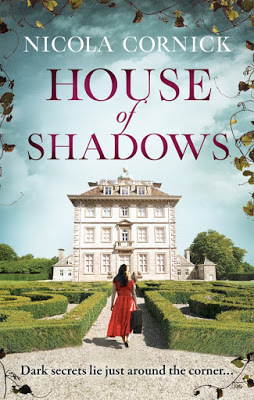
Here is the official "blurb" for the books, which tells its story much more efficiently than I could do --"Bestselling author and historian Nicola Cornick investigates the untold story of Elizabeth Stuart, the Winter Queen, and her connection to Ashdown House in Oxfordshire.
February 1662On the eve of her death Elizabeth Stuart hands her faithful cavalier William Craven an ancient pearl with magical properties to be kept safe for her rightful heir. Craven, distraught with grief, builds Ashdown Estate in Elizabeth’s memory and places the pearl at the centre.
February 1801Notorious Regency courtesan Lavinia Flyte is brought to Ashdown House with her protector, Lord Evershot, who is intent on uncovering the Winter Queen’s treasures. Evershot’s greedy pillage of the ancient house will unleash a dark power which has lain dormant for a hundred and fifty years.
February 2014Holly Ansell’s brother has gone missing. As Holly retraces his footsteps, she discovers that her brother was researching the mystery of Elizabeth Stuart and her alleged affair with William Craven. A battered mirror and the diary of a Regency courtesan are the only clues she has, but Holly is determined to discover the truth: Where is the fabled pearl that Elizabeth gave to William Craven? What happened to Lavinia Flyte? And who is the Winter Queen’s rightful heir?"
Victoria again. Now that must excite your interest as much as it does mine!
Nicola, both an author and historian, has written many best-selling historical novels. For a complete list, see her website, here.
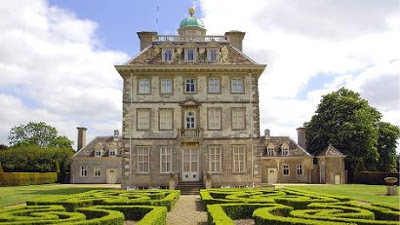 Ashdown House, OxfordshireHere is an excerpt from the Word Wenches Blog (where you will find wonderful news and views from some of your favorite authors). Cara Elliott a.k.a. Andrea Penrose interviews her fellow Word Wench, Nicola Cornick about House of Shadows."Cara/Andrea: One of the things that struck me was how seamlessly you blended your historical research with your creative imagination. Can you talk a little about how your real-life work as a curator at Ashdown House inspired the book?
Ashdown House, OxfordshireHere is an excerpt from the Word Wenches Blog (where you will find wonderful news and views from some of your favorite authors). Cara Elliott a.k.a. Andrea Penrose interviews her fellow Word Wench, Nicola Cornick about House of Shadows."Cara/Andrea: One of the things that struck me was how seamlessly you blended your historical research with your creative imagination. Can you talk a little about how your real-life work as a curator at Ashdown House inspired the book?Nicola: Thank you! Yes, House of Shadows is indeed a work of historical imagination in that I took the “facts” and filled in the gaps and in some cases, which I acknowledge, played fast and loose with reality. Over the years that I have worked at Ashdown I think I have absorbed so much of the history of the house and the people associated with it that I was able to draw on so many small aspects of that to make the whole – I met with a jewelry historian, for example, who had come to look at the pearls depicted in the portrait collection. She was the person who told me about the “cursed” pearl, which Elizabeth’s eldest daughter is wearing in one of the portraits. Then there was the fact that Ashdown is reputedly built on an ancient sacred site and its architecture incorporates a number of aspects that link it to the Order of the Knights of the Rosy Cross… I researched all these different stories as part of my work at Ashdown House and they all came together to inspire me and made their way into House of Shadows. One thing I did change, though. In the book I modeled Ashdown’s destruction on the true story of a different house—Coleshill—built at the same time and in the same style. I’m happy to say that Ashdown House is, of course, still standing and is open to visitors!"
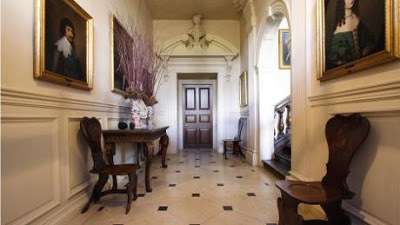 Entrance Hall, Ashdown House
Entrance Hall, Ashdown HouseThe National Trust owns Ashdown, but most of the house is occupied by private residents.
On a blog last spring, Nicola wrote about some of the landscape surrounding Ashdown. The entire blog post is here.Thursday, April 2, 2015. Here are a few highlights:
"The Sarsen Field is the first thing you see on the left of the drive as you approach the car park. This is open to everyone to walk in and is a fascinating are of Special Scientific Interest where the huge, ancient sarsen stones lie amongst the grass as they have done for thousands of years. Legend says they are an army turned to stone by the magician Merlin....
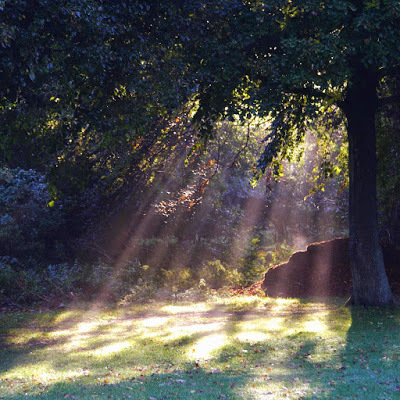
"The woodland dates back to when this was a medieval hunting ground and the deer still live here...
The badgers have been digging up the area around the grand avenue for almost 1000 years! There are also hidden geocaches, a tree trail and our Pixie Path. In the fields behind the wood the Balleroy ponies graze..."
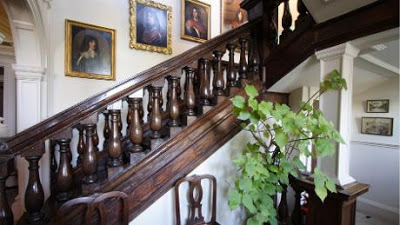 The Staircase
The StaircaseVisitors are guided up the flights of stairs to the cupola at the top where the views of the surrounding ancient landscape are stunning. Along the way, guides relate the history of the house and the family for whom it was created.
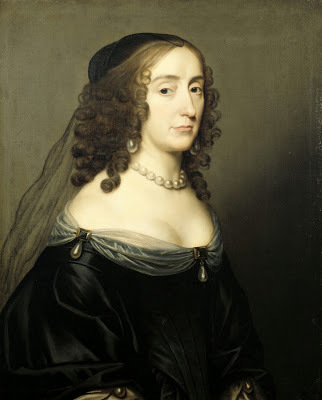 Elizabeth Stuart, Elizabeth of Bohemia, the Winter Queen
Elizabeth Stuart, Elizabeth of Bohemia, the Winter QueenOn her blog, Nicola has also written about one of her favorite secondary characters from House of Shadows, here.
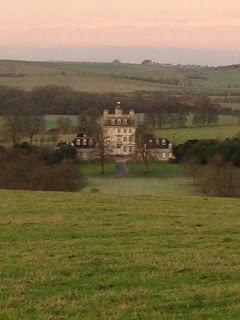 Ashdown House
Ashdown HouseThe house was originally designed as a hunting lodge.According to the 1994 edition of The Blue Guide to Country Houses of England, Ashdown's "exaggeratedly tall doll's-house-like proportions derive from the need to treat the house as a viewing stand for the chase--hence the balustrated platform and glazed cupola at the top of the typically 1660's hipped roof."
At Ashdown House in Oxfordshire, Nicola has been a volunteer guide and historian for the last fourteen years. Follow her on twitter @NicolaCornick and Facebook.
 Nicola Cornick
Nicola Cornick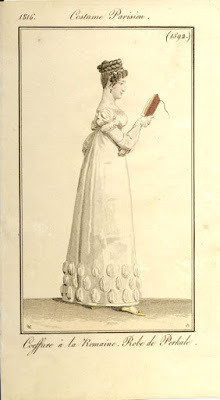 Patience required!
Patience required!Now I just have to settle in and bide my time until the book arrives! I hope to report back soon with a review and an interview with Nicola.
Published on November 11, 2015 00:30
November 9, 2015
A HAMLET FOR THE AGES
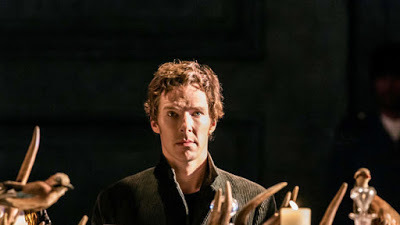
Victoria here, so glad I was able to see the showing of Benedict Cumberbatch as Hamlet, live from the National Theatre in London. Actually, it wasn't live (a repeat) and it wasn't from the NT (from the Barbican Theatre), but it was nevertheless terrific. Another showing will be in many theatres in the U.S. on November 10.
To see the upcoming schedules, click HERE
FOR THE ENCORE TRAILER, CLICK HERE. Scroll down little for the trailer.
Hamlet might be the most well-known of Shakespeare's tragedies and only second among the his total output to Romeo and Juliet. The role is one of those markers of an actor's prominence -- and it might even be the pinnacle of most careers.
In the conversation preceding the play from the NT, Cumberbatch is asked how he feels about reciting those most familiar lines "To be or not to be? That is the question." You will enjoy his answer!
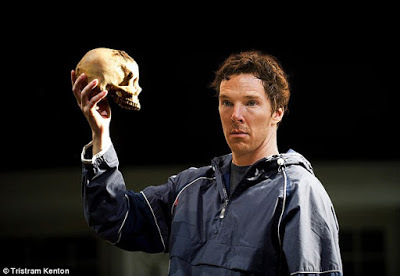 Alas! Poor Yorrick!
Alas! Poor Yorrick!Among the outstanding performances, actually the best of all, in my view, was Ciarán Hinds as Claudius, the Uncle/Stepfather of Hamlet.
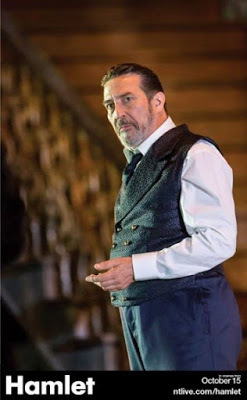 Ciarán Hinds
Ciarán HindsAt first I did not care much for Siân Brooke as Ophelia. But I warmed to her interpretation as the character's insanity develops. By her departure, I was entranced.
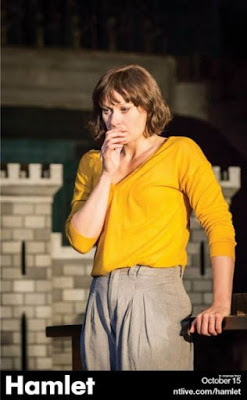 Siân Brooke
Siân Brooke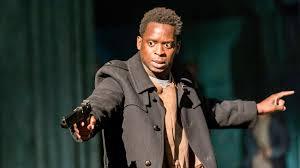 Kobna Holdbrook-Smith
Kobna Holdbrook-SmithAlso among the outstanding performances, again in my view alone, were Kobna Holdbrook-Smith as Laertes and Rudie Dharmalingram as Horatio. I also enjoyed the dual roles as acted by Karl Johnson: the Ghost of Hamlet's father (the late king) and the grave digger. In addition to many other appearances, Johnson previously played Twister, a favorite from Lark Rise to Candleford.
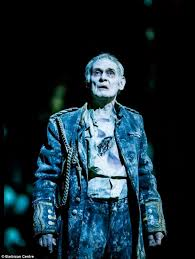 Karl Johnson
Karl JohnsonI can't begin to count how many times I've seen Hamlet. Being of a certain age, it has been more than I can count on my fingers. Maybe even my toes.
Here is a comment on the Cumberbatch version, directed by Lyndsey Turner, from a review in the New York Times by Ben Brantley on August 25, 2015: "Full of scenic spectacle and conceptual tweaks and quirks, this “Hamlet” is never boring. It is also never emotionally moving — except on those occasions when Mr. Cumberbatch’s Hamlet is alone with his thoughts, trying to make sense of a loud, importunate world that demands so much of him."
Sometimes the "conceptual tweaks" got in the way of the play, in my opinion, as when the characters in the darkened background moved as in slow motion, which drew my attention -- but perhaps would have been unnoticed within the theatre.
For obviously, watching the play from the stage is a very different experiences from sitting there live, but I'll take it when it gives me the opportunity to attend "live" theatre in London from my local movie seat, armed with popcorn and a fizzy drink.
The Telegraph reviewed the show and added a list of ten great recent Hamlets. To see their ratings, click here.
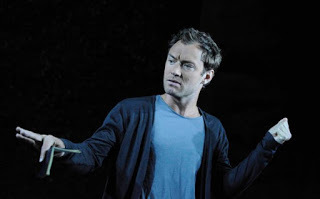 Jude Law, Wyndham Theatre, 2009
Jude Law, Wyndham Theatre, 2009I remember well being enchanted with the film of 1996, made by Kenneth Branagh and featuring Blenheim Palace as part of the set. Other actors in that excellent film were Kate Winslet, Derek Jacobi (who had performed the title role in years past), Julie Christie , and many other famous names making cameo performances. For the Branagh Hamlet trailer, click here.
Although his portrayal is definitely in an earlier tradition of the stage, it is also interesting to see Hamlet portrayed by Laurence Olivier, a true film classic from 1948. Click here for Olivier with Hamlet's famous soliloquy.
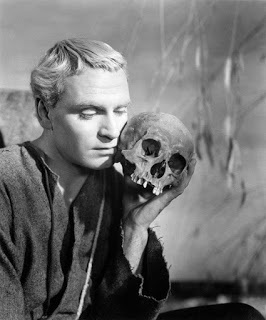 Laurence Olivier
Laurence OlivierJust in case I have whetted your appetite for more Hamlet, YouTube has many, many versions and the films are widely available at all the usual places.
Good Night, Sweet Prince!
Published on November 09, 2015 00:00
November 6, 2015
THE DUKE OF WELLINGTON TOUR - ARCHITECTURAL DETAILS: HIGHCLERE CASTLE
Published on November 06, 2015 00:30
November 4, 2015
MEN'S CLOTHING WAS A POPULAR SUBJECT AT THE JANE AUSTEN SOCIETY MEETING
MEN'S CLOTHING WAS A POPULAR SUBJECT OF THE JANE AUSTEN SOCIETY MEETING
Victoria here, reporting again from the Louisville, Kentucky, meeting of the Jane Austen Society. Unfortunately I missed the presentation on women's clothing, but I have to admit I liked all these presentations on men. Okay. No excuses.
First up was Brian Cushing with his Special Interest Session "Dressing Mr. Darcy."
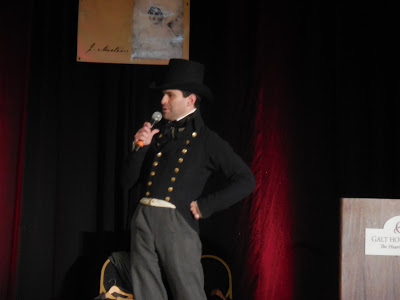 He started fully turned out, though he had to put his walking stick aside for the talk.
He started fully turned out, though he had to put his walking stick aside for the talk.
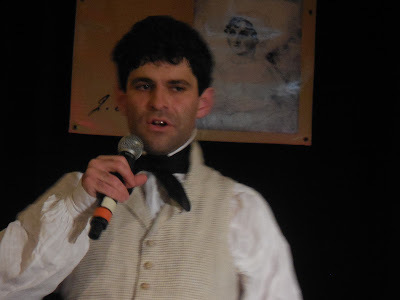 \Under the coat was a handsome waistcoat and black neckcloth or cravat.
\Under the coat was a handsome waistcoat and black neckcloth or cravat.
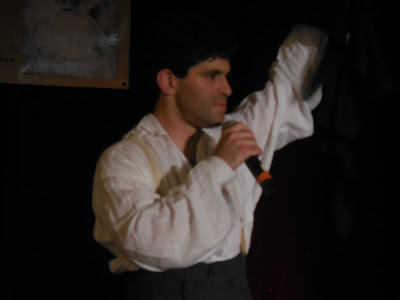 Removing the cravat
Removing the cravat
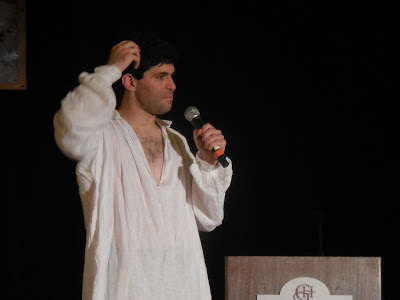 Left in his shirt he talked about how it did not open up all the way down, had extra long sleeves and tails which were pulled up to use as underwear beneath the trousers.
Left in his shirt he talked about how it did not open up all the way down, had extra long sleeves and tails which were pulled up to use as underwear beneath the trousers.
Michael Ramsey presented a Special Interest Session: Hero, Scoundrel, or Dandy: How to step back into Regency England.
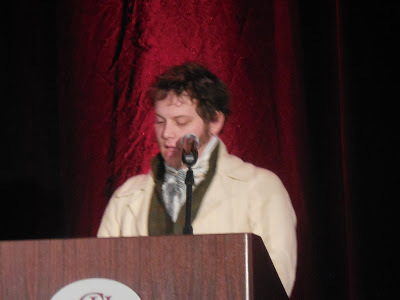 He is himself a tailor of Regency-era apparel.
He is himself a tailor of Regency-era apparel.
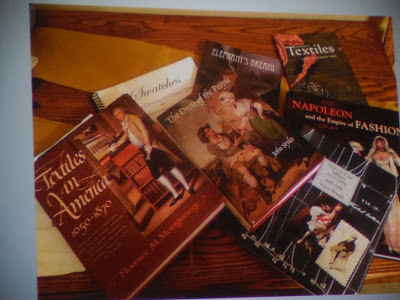 Some of his sources on regency clothing and behavior
Some of his sources on regency clothing and behavior
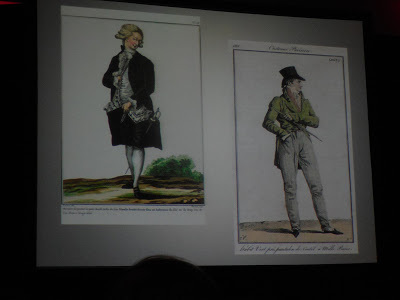
A few of the men;s fashion he showed.
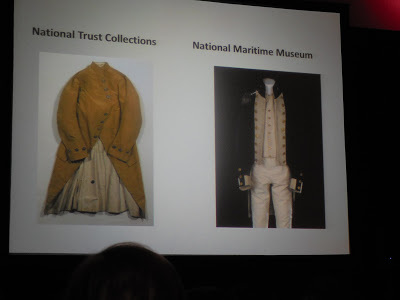
He particularly emphasized the importance of fabric quality in delineating the status of a fellow in regency days. Re-enactors and costumers need to avoid modern fabrics wherever they ca and be sure the quality of their wool, cotton, and silk is suitable for the character they portray,
Jeffrey Nigro and William Philips of Chicago spoke on "A Revolution in Masculine Style: How Beau Brummell Changed Jane Austen's World"
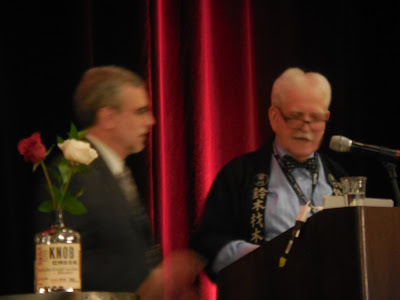 Jeff Nigro left, and William Philips, at the microphone.
Jeff Nigro left, and William Philips, at the microphone.
In many ways, the regency era was a time of revolutionary change; for example, determination of a person's status was changing from his amount of land ownership to his personal merit.
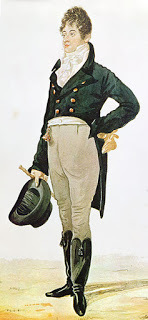 George Bryan Brummella.k.a. Beau Brummell 1778-1840Caricature by Robert Dighton, 1805 Present whereabouts unknown
George Bryan Brummella.k.a. Beau Brummell 1778-1840Caricature by Robert Dighton, 1805 Present whereabouts unknown
Though George Brummell attended Eton, he liked to pretend he came from nowhere; he thus created his own style and persona, calling himself "Beau" to indicate his spiritual excellence rising above the ordinary. Restrained elegance, superiority of bearing, and a ready wit combined to form his style of ostentatious understatement.
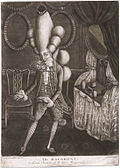 Philip Dawe The Macaroni, a real character at the late masquerade 1773 British Museum
Philip Dawe The Macaroni, a real character at the late masquerade 1773 British Museum
The style of the Macaroni was extreme, and often ridiculous. It was a revolt against this style that Beau Brummell created. He shunned hair powder and cut his hair much shorter. His clothing was subdued in in quiet colors rather than the bright brocades of the past.
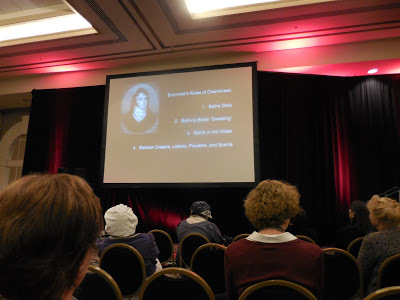 Enrapt listeners
Enrapt listeners
One of the most important features of Brummell's style was personal cleanliness. Instead of infrequent bathing, he promoted daily baths in hot water and avoided lotions, powder, and scents.
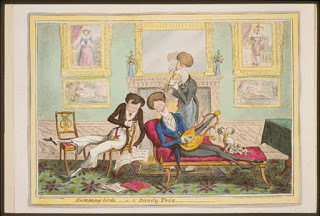 George Cruikshank, published by George HumphreyHummingbirds, or a Dandy Trio, published July 15, 1819
George Cruikshank, published by George HumphreyHummingbirds, or a Dandy Trio, published July 15, 1819
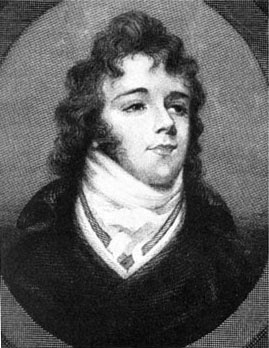 Beau Brummell
Beau Brummell
Wearing high collars and elaborate high cravats facilitated Brummell;s haughty attitude of looking down at others, enhanced by peering through his quizzing glass.
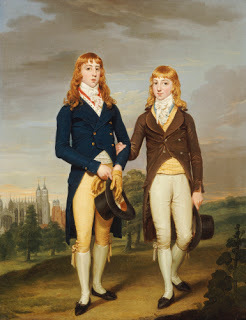 Francis Alleyne, Portrait of Two Eton Schoolboys in Ad Montem Dress
Francis Alleyne, Portrait of Two Eton Schoolboys in Ad Montem Dress
One source for Brummell's ideal of male fashion was the Eton "uniform."
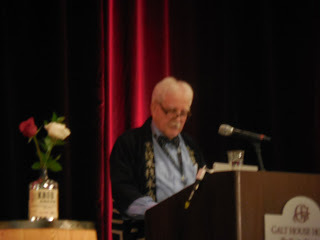 William Philips in a traditional Japanese jacket, a haori
William Philips in a traditional Japanese jacket, a haori
Jane Austen rarely described a gentleman's clothing in details, but the particulars of demeanor and attitude were often reflected in her delineation of character.
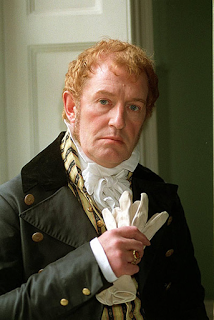 Sir Walter Elliott in Persuasion is vain and self-centered -- elaborately dressed.
Sir Walter Elliott in Persuasion is vain and self-centered -- elaborately dressed.
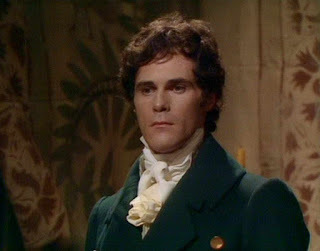 The worthy Mr. Darcy in Pride and Prejudice is the epitome of understated elegance like Brummell's.
The worthy Mr. Darcy in Pride and Prejudice is the epitome of understated elegance like Brummell's.
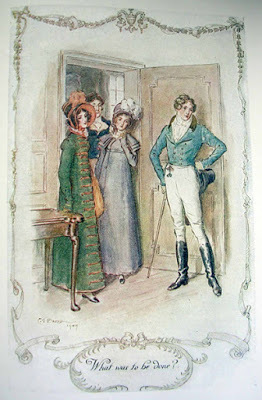 Mr. Frank Churchill's coat is not described, but the fact he goes to London for a haircut perfectly characterizes him in Emma.
Mr. Frank Churchill's coat is not described, but the fact he goes to London for a haircut perfectly characterizes him in Emma.
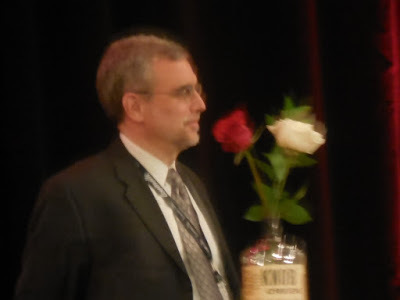 Jeffrey Nigro in a business suit directly evolved from Beau Brummell
Jeffrey Nigro in a business suit directly evolved from Beau Brummell
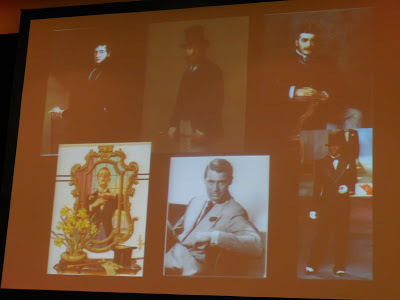 How the Brummell Style has evolved through the years.
How the Brummell Style has evolved through the years.
 2013 G8 Summit, Lough Erne, Northern IrelandStill with us is the essence of the Brummell style, white shirt, dark coat, dark or buff trousers.
2013 G8 Summit, Lough Erne, Northern IrelandStill with us is the essence of the Brummell style, white shirt, dark coat, dark or buff trousers.
This is just brief taste of what the presenters gave us....celebrating the men in Jane Austen's World.
Victoria here, reporting again from the Louisville, Kentucky, meeting of the Jane Austen Society. Unfortunately I missed the presentation on women's clothing, but I have to admit I liked all these presentations on men. Okay. No excuses.
First up was Brian Cushing with his Special Interest Session "Dressing Mr. Darcy."
 He started fully turned out, though he had to put his walking stick aside for the talk.
He started fully turned out, though he had to put his walking stick aside for the talk. \Under the coat was a handsome waistcoat and black neckcloth or cravat.
\Under the coat was a handsome waistcoat and black neckcloth or cravat. Removing the cravat
Removing the cravat Left in his shirt he talked about how it did not open up all the way down, had extra long sleeves and tails which were pulled up to use as underwear beneath the trousers.
Left in his shirt he talked about how it did not open up all the way down, had extra long sleeves and tails which were pulled up to use as underwear beneath the trousers.Michael Ramsey presented a Special Interest Session: Hero, Scoundrel, or Dandy: How to step back into Regency England.
 He is himself a tailor of Regency-era apparel.
He is himself a tailor of Regency-era apparel. Some of his sources on regency clothing and behavior
Some of his sources on regency clothing and behavior
A few of the men;s fashion he showed.

He particularly emphasized the importance of fabric quality in delineating the status of a fellow in regency days. Re-enactors and costumers need to avoid modern fabrics wherever they ca and be sure the quality of their wool, cotton, and silk is suitable for the character they portray,
Jeffrey Nigro and William Philips of Chicago spoke on "A Revolution in Masculine Style: How Beau Brummell Changed Jane Austen's World"
 Jeff Nigro left, and William Philips, at the microphone.
Jeff Nigro left, and William Philips, at the microphone.In many ways, the regency era was a time of revolutionary change; for example, determination of a person's status was changing from his amount of land ownership to his personal merit.
 George Bryan Brummella.k.a. Beau Brummell 1778-1840Caricature by Robert Dighton, 1805 Present whereabouts unknown
George Bryan Brummella.k.a. Beau Brummell 1778-1840Caricature by Robert Dighton, 1805 Present whereabouts unknownThough George Brummell attended Eton, he liked to pretend he came from nowhere; he thus created his own style and persona, calling himself "Beau" to indicate his spiritual excellence rising above the ordinary. Restrained elegance, superiority of bearing, and a ready wit combined to form his style of ostentatious understatement.
 Philip Dawe The Macaroni, a real character at the late masquerade 1773 British Museum
Philip Dawe The Macaroni, a real character at the late masquerade 1773 British MuseumThe style of the Macaroni was extreme, and often ridiculous. It was a revolt against this style that Beau Brummell created. He shunned hair powder and cut his hair much shorter. His clothing was subdued in in quiet colors rather than the bright brocades of the past.
 Enrapt listeners
Enrapt listenersOne of the most important features of Brummell's style was personal cleanliness. Instead of infrequent bathing, he promoted daily baths in hot water and avoided lotions, powder, and scents.
 George Cruikshank, published by George HumphreyHummingbirds, or a Dandy Trio, published July 15, 1819
George Cruikshank, published by George HumphreyHummingbirds, or a Dandy Trio, published July 15, 1819 Beau Brummell
Beau Brummell Wearing high collars and elaborate high cravats facilitated Brummell;s haughty attitude of looking down at others, enhanced by peering through his quizzing glass.
 Francis Alleyne, Portrait of Two Eton Schoolboys in Ad Montem Dress
Francis Alleyne, Portrait of Two Eton Schoolboys in Ad Montem DressOne source for Brummell's ideal of male fashion was the Eton "uniform."
 William Philips in a traditional Japanese jacket, a haori
William Philips in a traditional Japanese jacket, a haoriJane Austen rarely described a gentleman's clothing in details, but the particulars of demeanor and attitude were often reflected in her delineation of character.
 Sir Walter Elliott in Persuasion is vain and self-centered -- elaborately dressed.
Sir Walter Elliott in Persuasion is vain and self-centered -- elaborately dressed. The worthy Mr. Darcy in Pride and Prejudice is the epitome of understated elegance like Brummell's.
The worthy Mr. Darcy in Pride and Prejudice is the epitome of understated elegance like Brummell's. Mr. Frank Churchill's coat is not described, but the fact he goes to London for a haircut perfectly characterizes him in Emma.
Mr. Frank Churchill's coat is not described, but the fact he goes to London for a haircut perfectly characterizes him in Emma. Jeffrey Nigro in a business suit directly evolved from Beau Brummell
Jeffrey Nigro in a business suit directly evolved from Beau Brummell How the Brummell Style has evolved through the years.
How the Brummell Style has evolved through the years. 2013 G8 Summit, Lough Erne, Northern IrelandStill with us is the essence of the Brummell style, white shirt, dark coat, dark or buff trousers.
2013 G8 Summit, Lough Erne, Northern IrelandStill with us is the essence of the Brummell style, white shirt, dark coat, dark or buff trousers.This is just brief taste of what the presenters gave us....celebrating the men in Jane Austen's World.
Published on November 04, 2015 00:30
November 2, 2015
MORE FROM JASNA AGM
ASSORTED TIDBITS FROM JASNA AGM
IN RETROSPECT:
1. Sitting at the Emporium Wisconsin Table Selling Calendars and jewelry
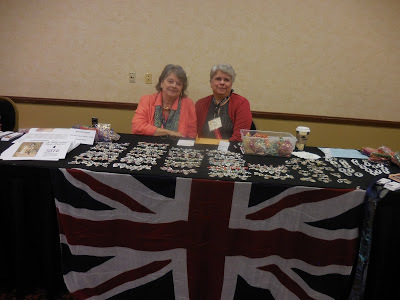 Mary and Sara 'man' the table
Mary and Sara 'man' the table
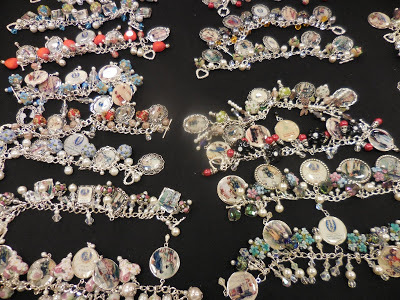
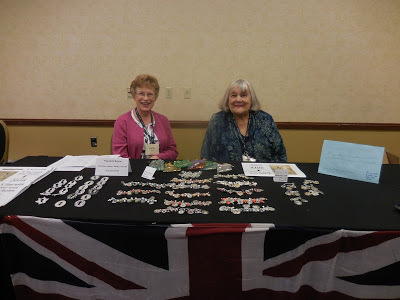 Kathy and Mary Anne at the WI table
Kathy and Mary Anne at the WI table
2. Shopping in the Emporium
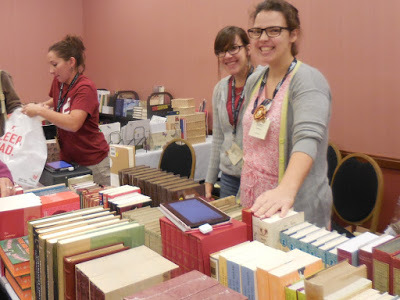 At my favorite Jane Austen BooksVisit them here.
At my favorite Jane Austen BooksVisit them here.
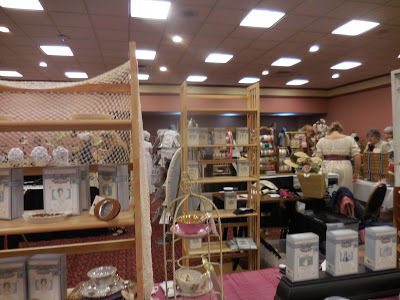 Teas and ribbons....
Teas and ribbons....
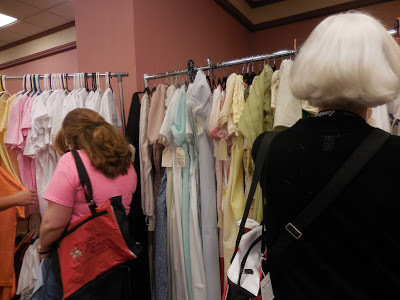 Gowns of all sizes and shades...
Gowns of all sizes and shades...
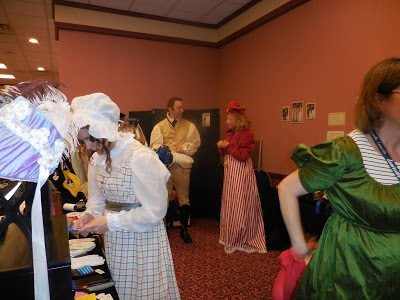
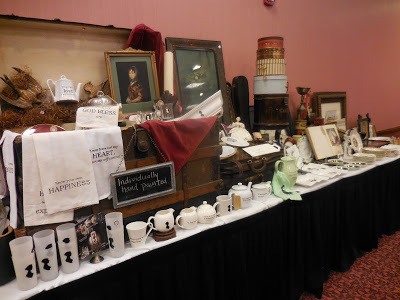
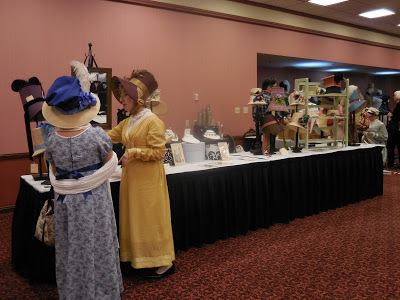
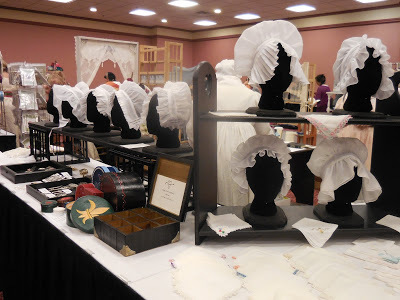 Mob caps
Mob caps
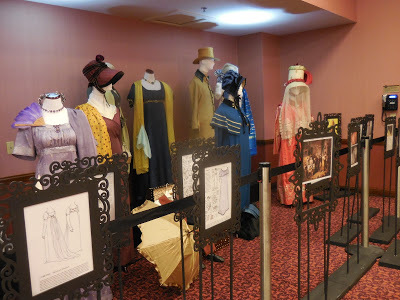 More gowns
More gowns
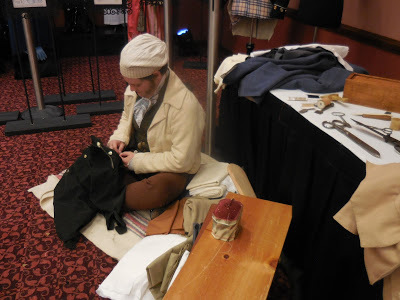 The gentleman's tailor
The gentleman's tailor
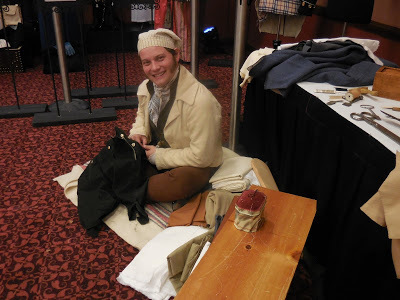
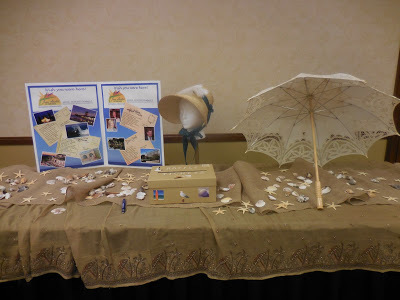 A display inviting us to the 2017 JASNA AGM in Huntington Beach, CAFor More information click here.
A display inviting us to the 2017 JASNA AGM in Huntington Beach, CAFor More information click here.
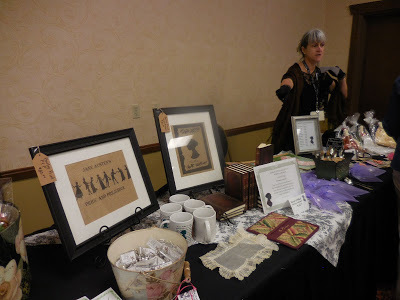
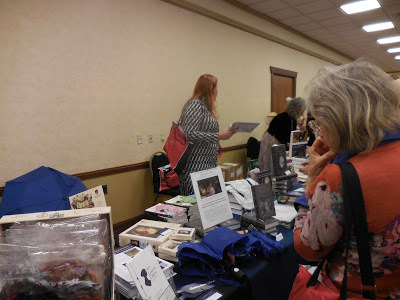 Our Friends from Chawton House Libraryfor more information, click here.
Our Friends from Chawton House Libraryfor more information, click here.
3. Making my "Breast Knot" otherwise known as a beribboned posey
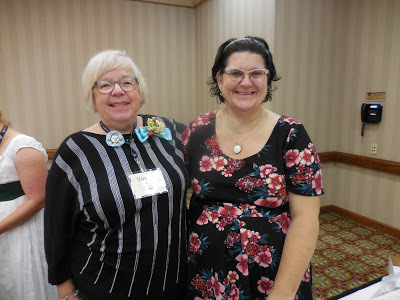 Victoria wearing her creation with instructor Julie Rockhold
Victoria wearing her creation with instructor Julie Rockhold
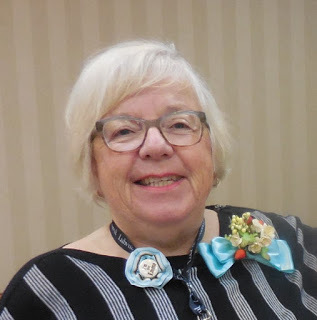 It's the one on the right, ribbons and flowers,(The smaller one says 'I'm for Emma,' advertising the 2016 AGM.)
It's the one on the right, ribbons and flowers,(The smaller one says 'I'm for Emma,' advertising the 2016 AGM.)

Choose flowers and ribbons
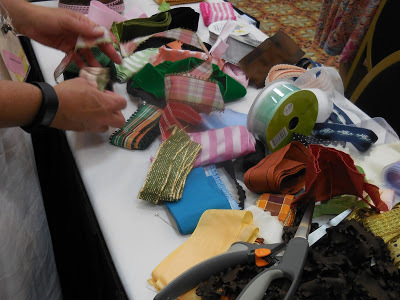

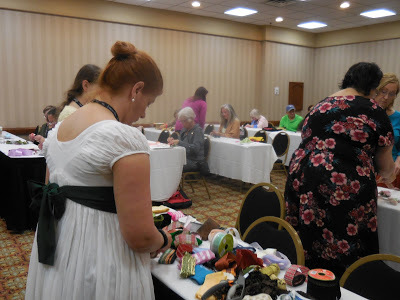
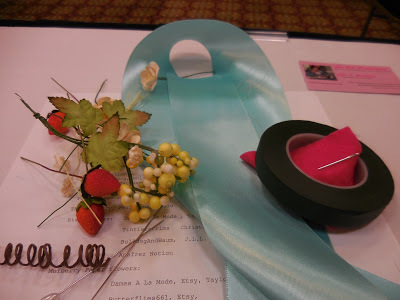
My choices, above and below
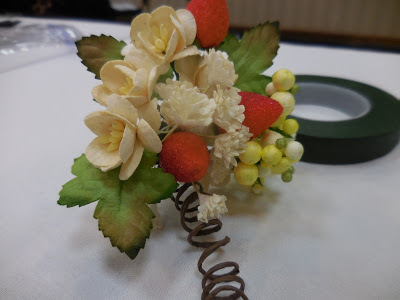
4. Studying the 'History of Women's Writing' Panels
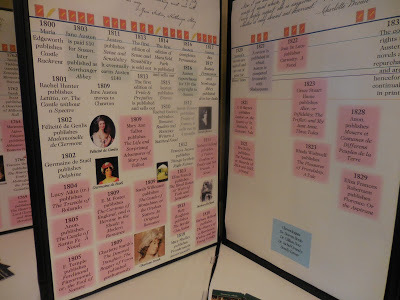
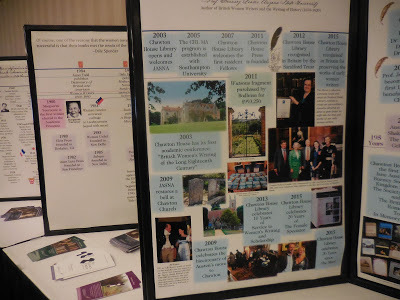
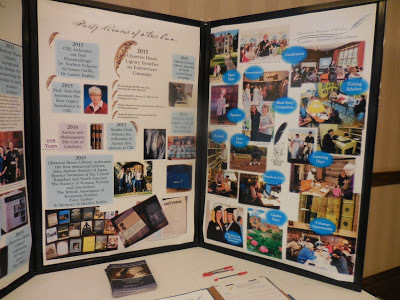
5. Listening to wonderful speakers
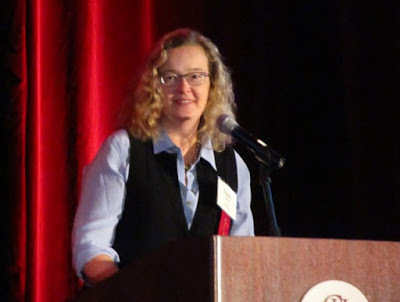 Inger Brodey presented the AGM Opening Plenary"Making Sense of Sensibility in Jane Austen's World"photo courtesy Dave O'Brien
Inger Brodey presented the AGM Opening Plenary"Making Sense of Sensibility in Jane Austen's World"photo courtesy Dave O'Brien
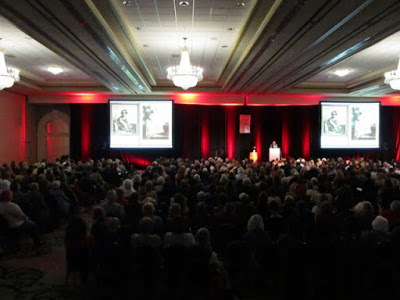 A Full Housephoto courtesy Dave O'Brien
A Full Housephoto courtesy Dave O'Brien
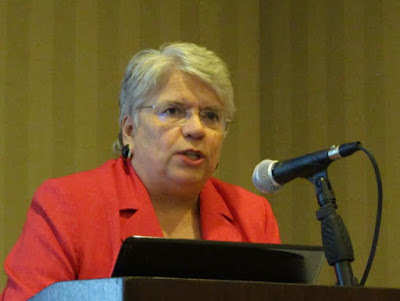 Sara Bowen presented "Village Life in Jane Austen's World: The View from the Parsonage."photo courtesy Dave O'Brien
Sara Bowen presented "Village Life in Jane Austen's World: The View from the Parsonage."photo courtesy Dave O'Brien
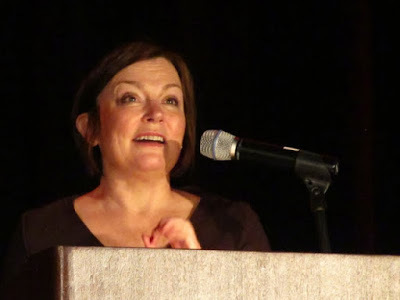 Amanda Vickery gave a plenary session, the Carol Medine Moss Keynote Lecture"No Happy Ending? At Home with Miss Bates in Georgian England"photo courtesy Dave O'Brien
Amanda Vickery gave a plenary session, the Carol Medine Moss Keynote Lecture"No Happy Ending? At Home with Miss Bates in Georgian England"photo courtesy Dave O'Brien
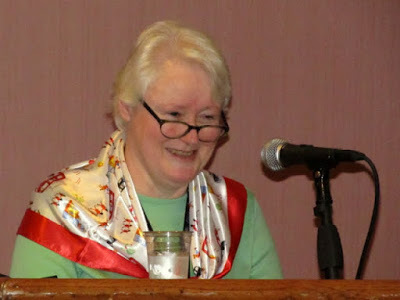 Sheryl Craig spoke on "Jane Austen and the Master Spy."photo courtesy Dave O'Brien
Sheryl Craig spoke on "Jane Austen and the Master Spy."photo courtesy Dave O'Brien
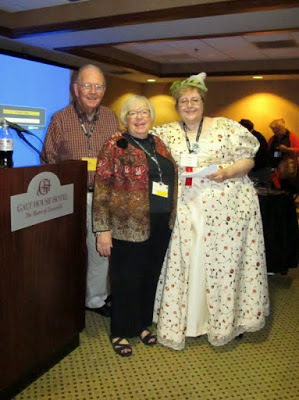 Ed, Victoria, and Susan Forgue after our presentation"London High Society in Austen's Novels"photo courtesy Dave O'Brien
Ed, Victoria, and Susan Forgue after our presentation"London High Society in Austen's Novels"photo courtesy Dave O'Brien
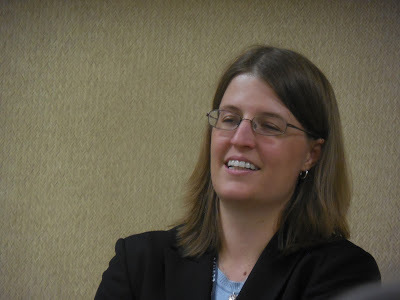 Burney Society Luncheon speaker Hilary Havens of the University of TennesseeHer topic for our meeting was "Two Decades of the Burney Society and Burney Studies."
Burney Society Luncheon speaker Hilary Havens of the University of TennesseeHer topic for our meeting was "Two Decades of the Burney Society and Burney Studies."
Back at JASNA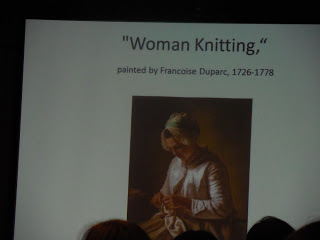 Above and below, slides from the excellent presentation by Shannon Campbell of the Edmonton Region: The Beast That Made Britain Strong."Somehow I missed getting her picture.
Above and below, slides from the excellent presentation by Shannon Campbell of the Edmonton Region: The Beast That Made Britain Strong."Somehow I missed getting her picture.
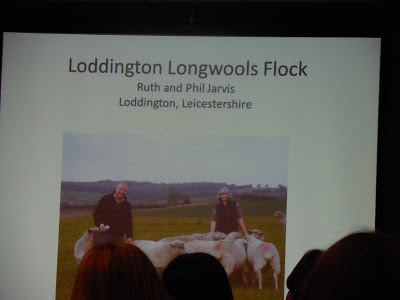 Hint: That beast goes 'Baaaaaa.'
Hint: That beast goes 'Baaaaaa.'
I have previously reported on the closing talk by Dr. Rachel Brownstein (here)
and I will report on several presentations concerning the men of the regency era soon.The AGM was truly memorable. Thanks again, Louisville!
IN RETROSPECT:
1. Sitting at the Emporium Wisconsin Table Selling Calendars and jewelry
 Mary and Sara 'man' the table
Mary and Sara 'man' the table
 Kathy and Mary Anne at the WI table
Kathy and Mary Anne at the WI table2. Shopping in the Emporium
 At my favorite Jane Austen BooksVisit them here.
At my favorite Jane Austen BooksVisit them here. Teas and ribbons....
Teas and ribbons.... Gowns of all sizes and shades...
Gowns of all sizes and shades...


 Mob caps
Mob caps More gowns
More gowns The gentleman's tailor
The gentleman's tailor
 A display inviting us to the 2017 JASNA AGM in Huntington Beach, CAFor More information click here.
A display inviting us to the 2017 JASNA AGM in Huntington Beach, CAFor More information click here.
 Our Friends from Chawton House Libraryfor more information, click here.
Our Friends from Chawton House Libraryfor more information, click here.3. Making my "Breast Knot" otherwise known as a beribboned posey
 Victoria wearing her creation with instructor Julie Rockhold
Victoria wearing her creation with instructor Julie Rockhold It's the one on the right, ribbons and flowers,(The smaller one says 'I'm for Emma,' advertising the 2016 AGM.)
It's the one on the right, ribbons and flowers,(The smaller one says 'I'm for Emma,' advertising the 2016 AGM.)
Choose flowers and ribbons




My choices, above and below

4. Studying the 'History of Women's Writing' Panels



5. Listening to wonderful speakers
 Inger Brodey presented the AGM Opening Plenary"Making Sense of Sensibility in Jane Austen's World"photo courtesy Dave O'Brien
Inger Brodey presented the AGM Opening Plenary"Making Sense of Sensibility in Jane Austen's World"photo courtesy Dave O'Brien A Full Housephoto courtesy Dave O'Brien
A Full Housephoto courtesy Dave O'Brien Sara Bowen presented "Village Life in Jane Austen's World: The View from the Parsonage."photo courtesy Dave O'Brien
Sara Bowen presented "Village Life in Jane Austen's World: The View from the Parsonage."photo courtesy Dave O'Brien Amanda Vickery gave a plenary session, the Carol Medine Moss Keynote Lecture"No Happy Ending? At Home with Miss Bates in Georgian England"photo courtesy Dave O'Brien
Amanda Vickery gave a plenary session, the Carol Medine Moss Keynote Lecture"No Happy Ending? At Home with Miss Bates in Georgian England"photo courtesy Dave O'Brien Sheryl Craig spoke on "Jane Austen and the Master Spy."photo courtesy Dave O'Brien
Sheryl Craig spoke on "Jane Austen and the Master Spy."photo courtesy Dave O'Brien Ed, Victoria, and Susan Forgue after our presentation"London High Society in Austen's Novels"photo courtesy Dave O'Brien
Ed, Victoria, and Susan Forgue after our presentation"London High Society in Austen's Novels"photo courtesy Dave O'Brien Burney Society Luncheon speaker Hilary Havens of the University of TennesseeHer topic for our meeting was "Two Decades of the Burney Society and Burney Studies."
Burney Society Luncheon speaker Hilary Havens of the University of TennesseeHer topic for our meeting was "Two Decades of the Burney Society and Burney Studies."Back at JASNA
 Above and below, slides from the excellent presentation by Shannon Campbell of the Edmonton Region: The Beast That Made Britain Strong."Somehow I missed getting her picture.
Above and below, slides from the excellent presentation by Shannon Campbell of the Edmonton Region: The Beast That Made Britain Strong."Somehow I missed getting her picture. Hint: That beast goes 'Baaaaaa.'
Hint: That beast goes 'Baaaaaa.'I have previously reported on the closing talk by Dr. Rachel Brownstein (here)
and I will report on several presentations concerning the men of the regency era soon.The AGM was truly memorable. Thanks again, Louisville!
Published on November 02, 2015 00:30
October 30, 2015
THE DUKE OF WELLINGTON TOUR: WALKING HIGHCLERE
Kristine here - As some of you may recall, I posted before the Tour started about how much I was looking forward to walking the grounds at Highclere Castle. As depicted on Downton Abbey, the grounds always seem interesting, inviting and in need of my closer perusal. When we visited, I had the opportunity to set off by myself and to simply take in the gardens, the countryside and the grounds. Here, I offer you just a few of the views I was fortunate enough to encounter. Can you spot the one photo I didn't take myself?
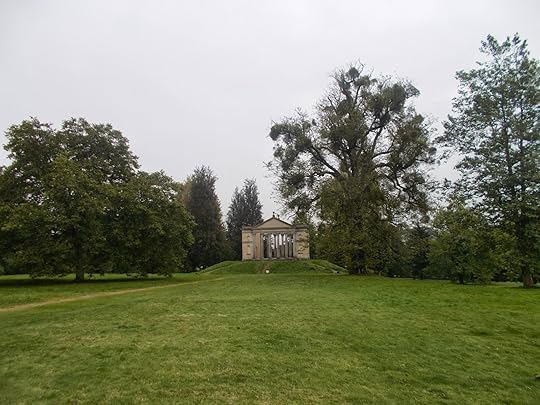
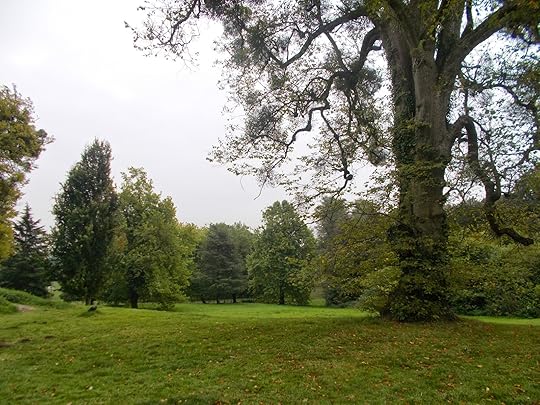
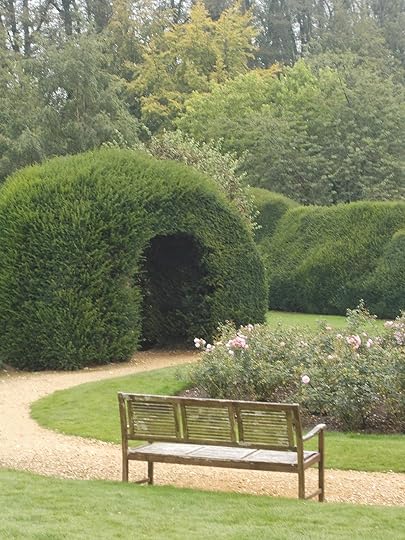
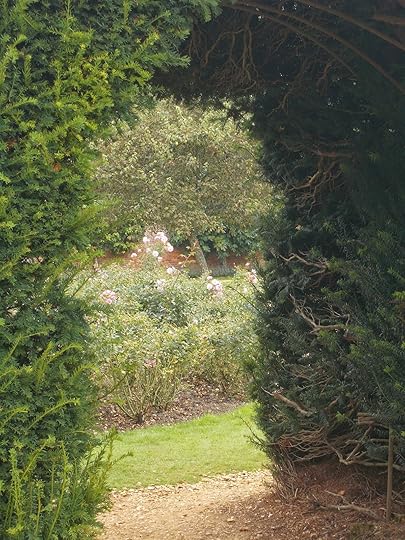


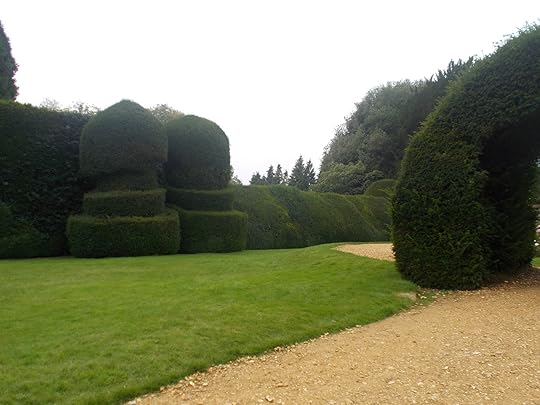
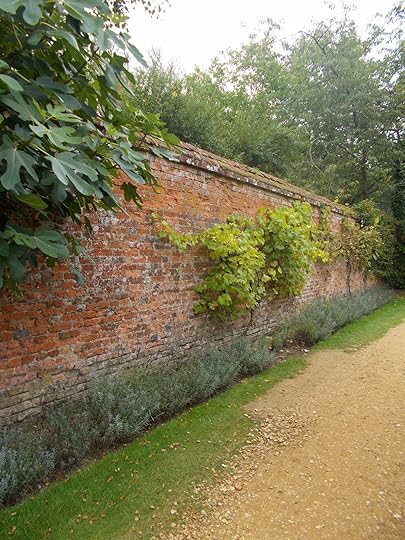
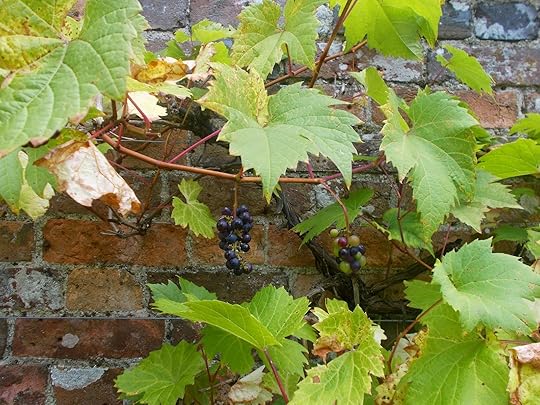
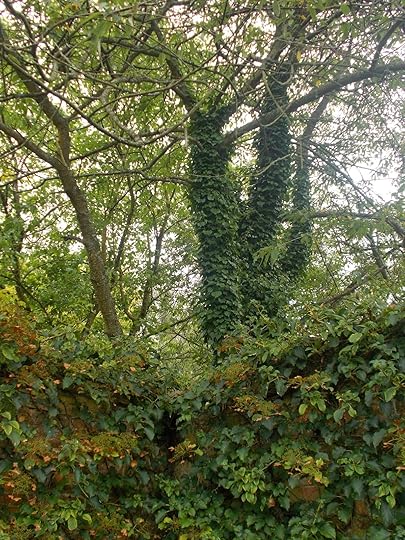

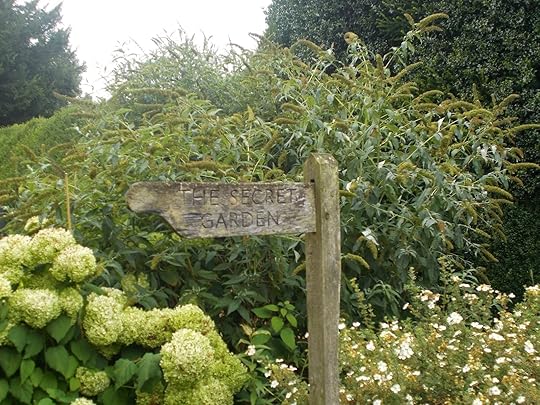
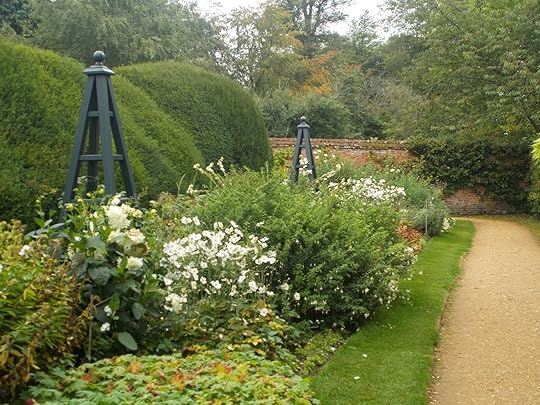
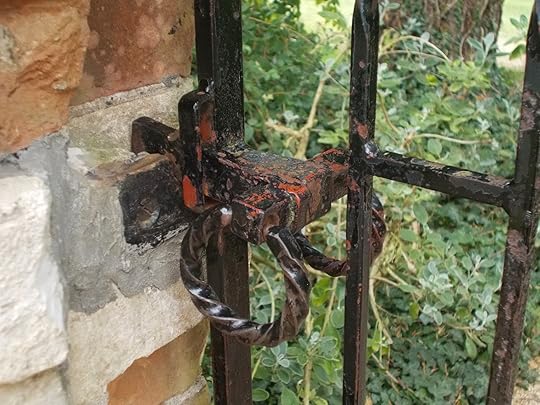
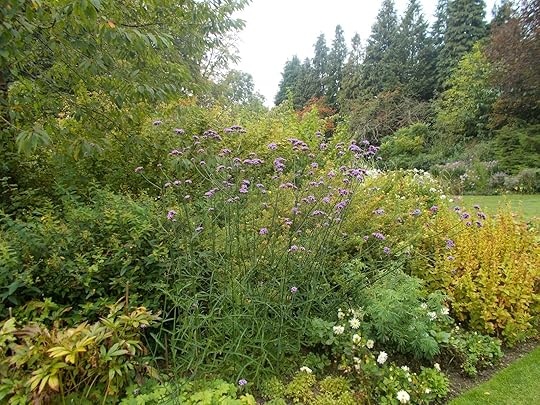
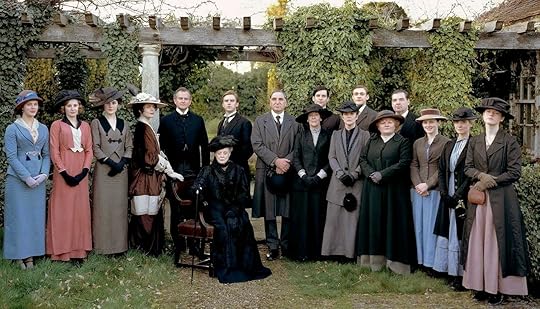
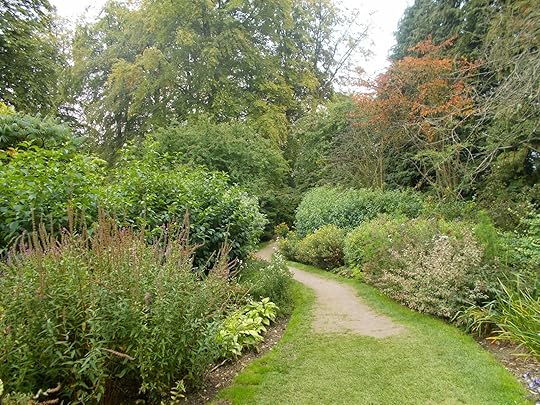
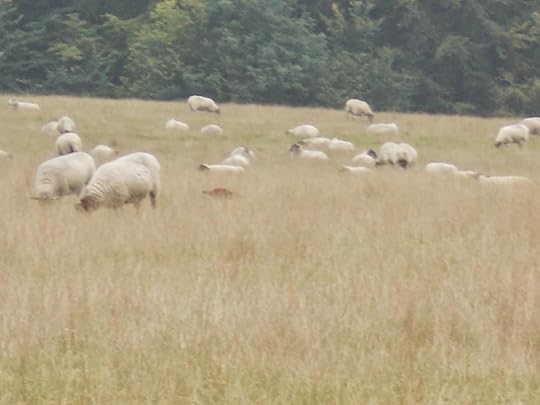
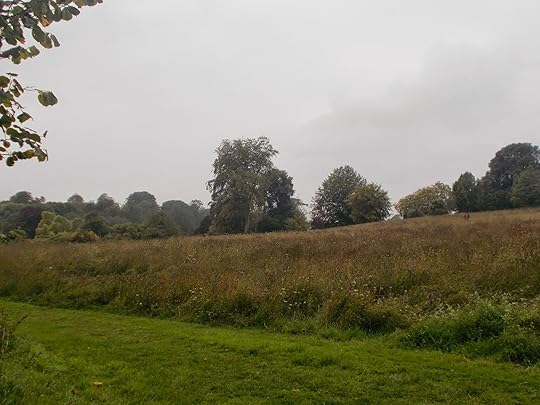
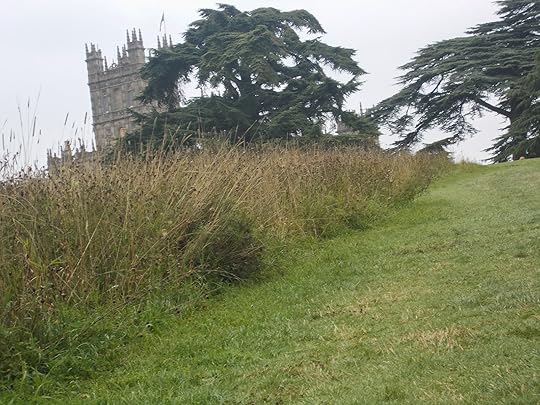
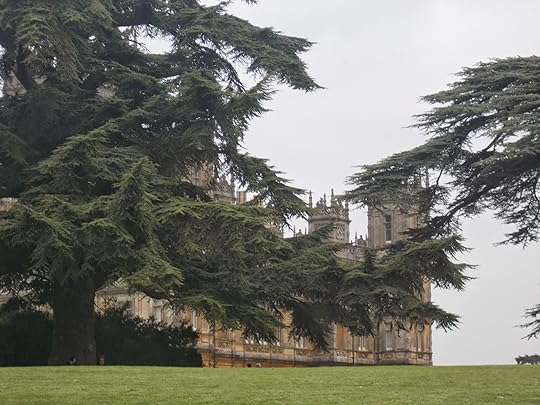
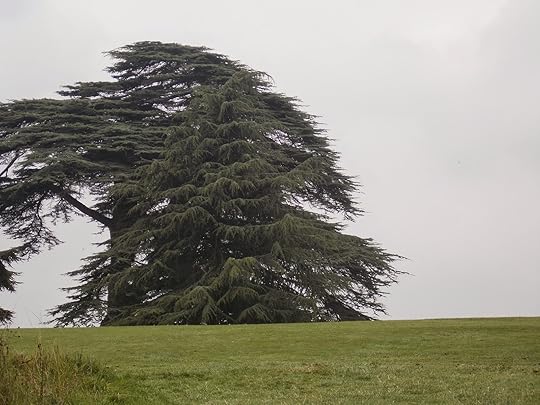
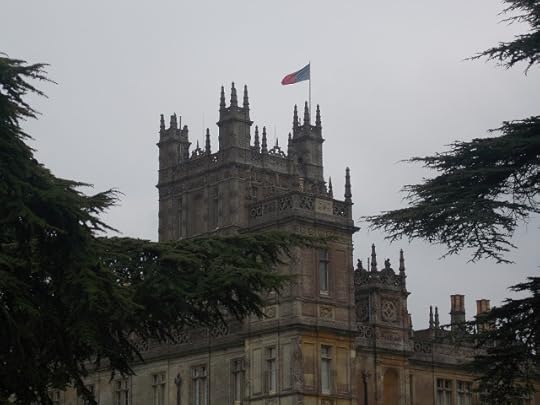
Published on October 30, 2015 05:00
October 28, 2015
LOCUST GROVE KENTUCKY
Locust Grove is advertised as "where Louisville began." The mansion was built in the 1790's by William and Lucy Croghan. They raised their family here and a frequent resident was Lucy's brother, General George Rogers Clark, a hero of the Revolutionary War.
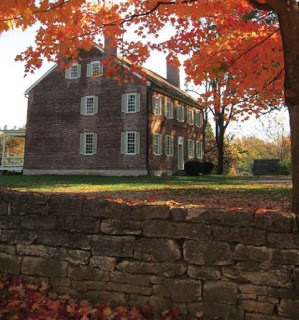 The lovely bright sunshine prevented me from photographing this side of the mansion.This view is from their website, here.
The lovely bright sunshine prevented me from photographing this side of the mansion.This view is from their website, here.
Also from the website: "This c.1792 Georgian mansion tells the story of its builders, William and Lucy Clark Croghan, and the story of American beginnings. William and Lucy Clark Croghan, along with Lucy’s brother, General George Rogers Clark, welcomed a generation of American luminaries to their home to rest, dialogue, campaign, and duel. Presidents James Monroe and Andrew Jackson, John James Audubon, Cassius Marcellus Clay, and Lewis and Clark—among others—all passed through Locust Grove. Now a National Historic Landmark, Locust Grove is a unique example of early Kentucky architecture, craftsmanship, and history."
The rest of the pictures are mine. And a perfect day for the camera it was.
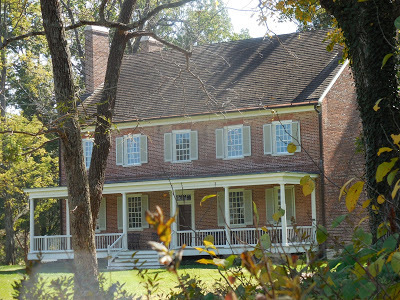
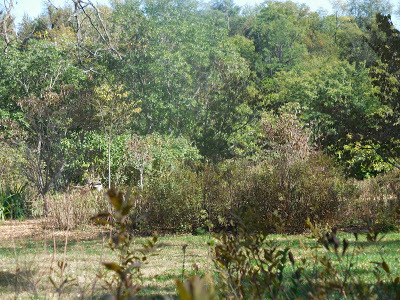 The garden was moving into its post-harvest phase.
The garden was moving into its post-harvest phase.
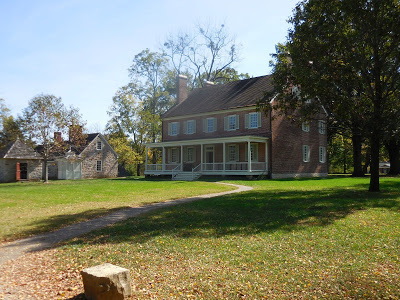
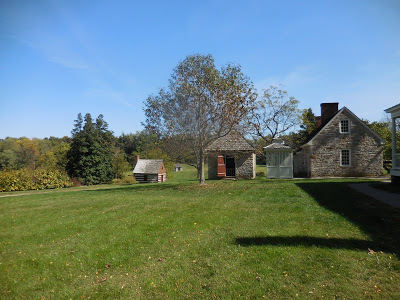
Below are portraits of Lucy Clark (1765-1838) and William Croghan (1752-1822) in the Dining Room.
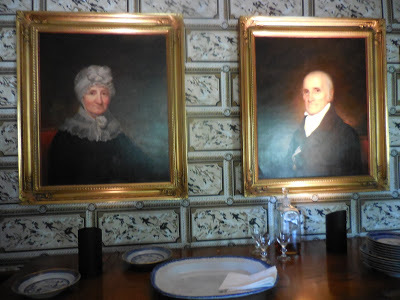 Note the the hand-blocked wallpaper design.
Note the the hand-blocked wallpaper design.
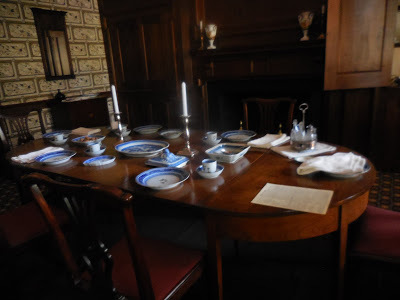
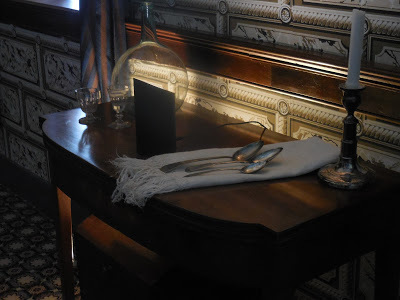
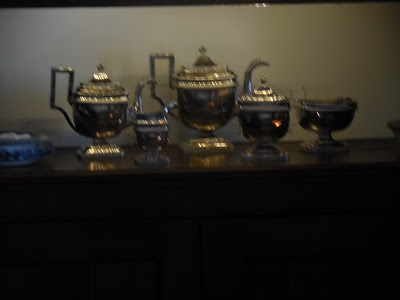 The silver coffee and tea service was made in Philadelphia with the family crest.
The silver coffee and tea service was made in Philadelphia with the family crest.
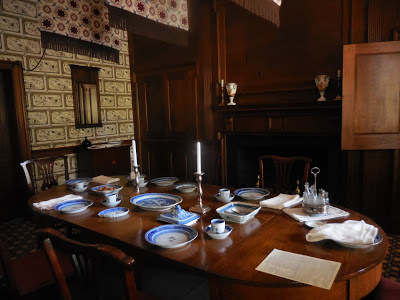 Dining Room, as it was in 1811
Dining Room, as it was in 1811
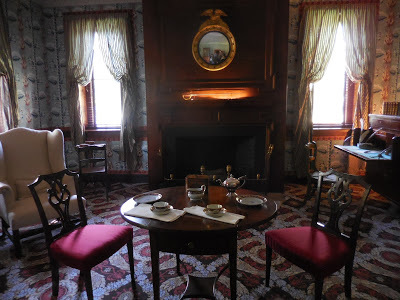
Small parlor, as of 1815
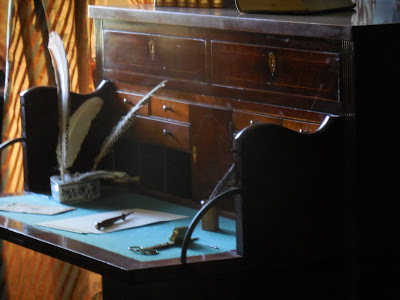
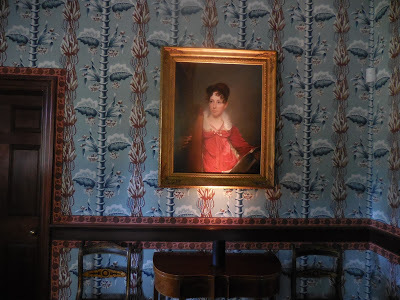 Again, the drawing room wallpaper is worthy of note.
Again, the drawing room wallpaper is worthy of note.
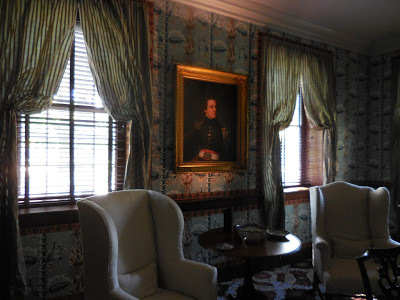
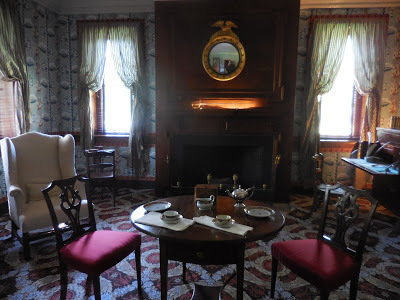 The imported Brussels carpet is particularly fine.
The imported Brussels carpet is particularly fine.
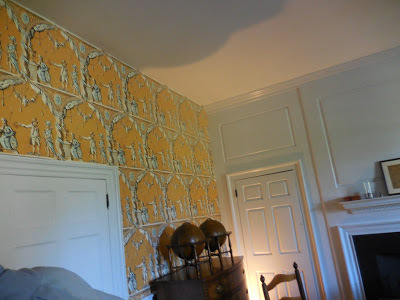 Bedroom of George Rogers Clark from 1809 until his death in 1818
Bedroom of George Rogers Clark from 1809 until his death in 1818
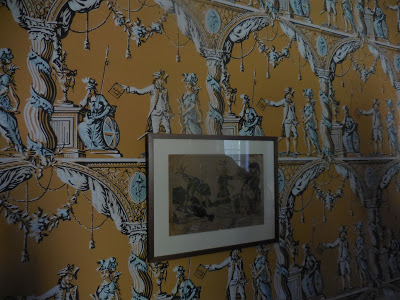 More fascinating wallpaper, with an American Revolutionary theme
More fascinating wallpaper, with an American Revolutionary theme
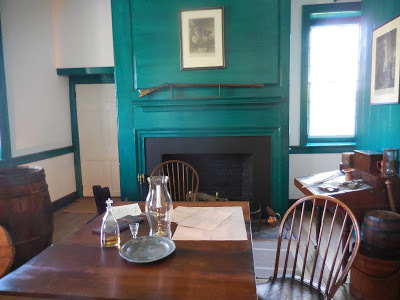 These walls of the Farm Office are painted in verdigris, which was explained as an odiferous compound in which one part was urine or excrement. Rarely used in bedroom I presume.
These walls of the Farm Office are painted in verdigris, which was explained as an odiferous compound in which one part was urine or excrement. Rarely used in bedroom I presume.
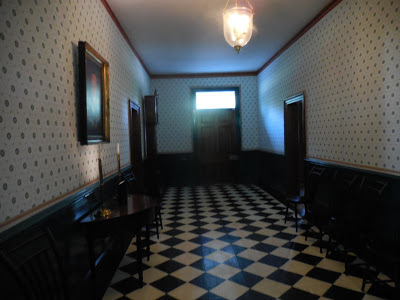 Central Hall on the Ground Floor
Central Hall on the Ground Floor
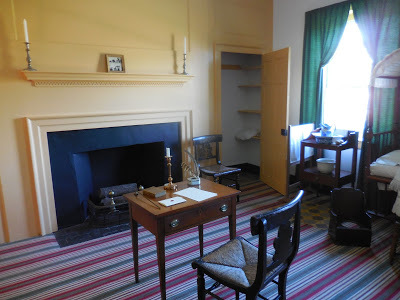 Family Guest Room: I found the striped carpeting interesting.
Family Guest Room: I found the striped carpeting interesting.
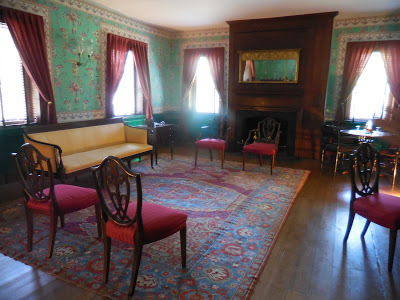 Great Parlour on the second floor, as of 1811, used for family gatherings, as a ballroom, for playing games and many other activities.
Great Parlour on the second floor, as of 1811, used for family gatherings, as a ballroom, for playing games and many other activities.
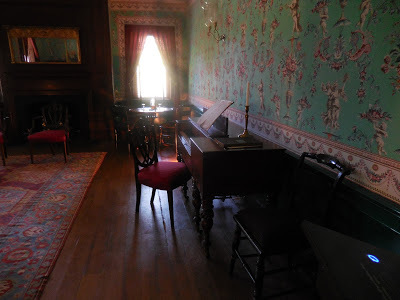
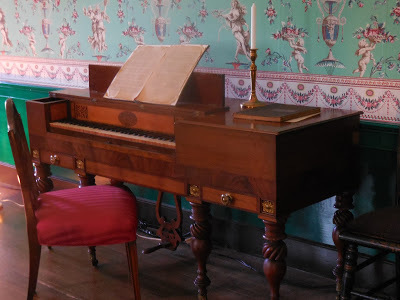 According to the website, " The fortepiano was made by Broadwood in London in 1806 and is still used for concerts."
According to the website, " The fortepiano was made by Broadwood in London in 1806 and is still used for concerts."
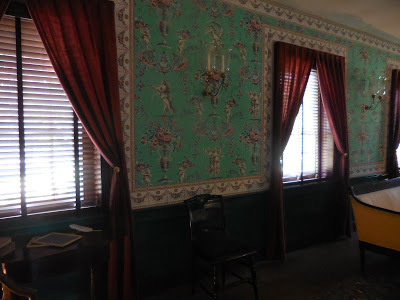
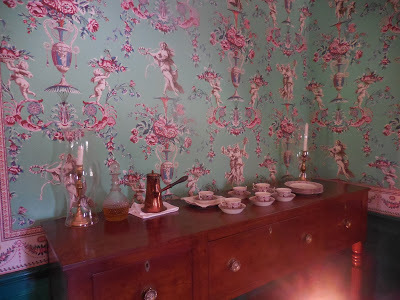
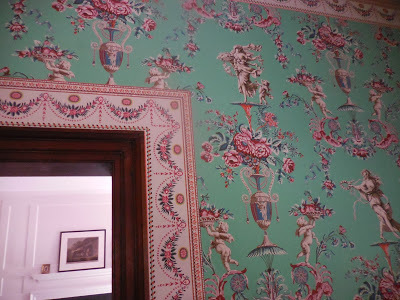 The wallpaper is a reproduction of the original Arabesque pattern.
The wallpaper is a reproduction of the original Arabesque pattern.
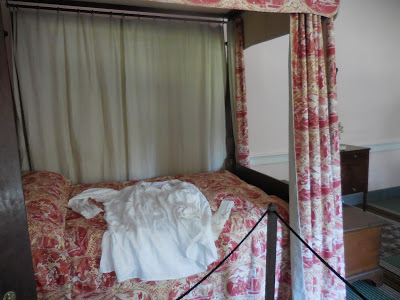 The Rose Room, with cradle, below
The Rose Room, with cradle, below
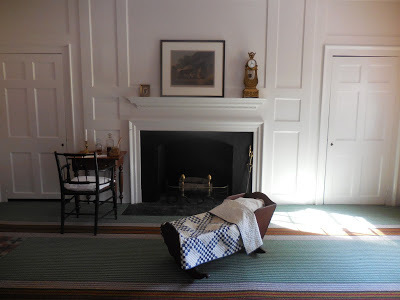
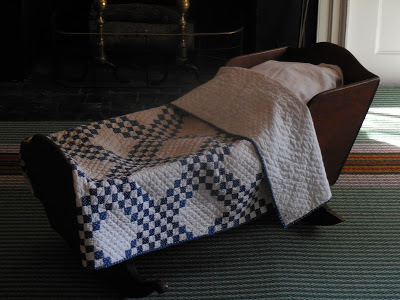
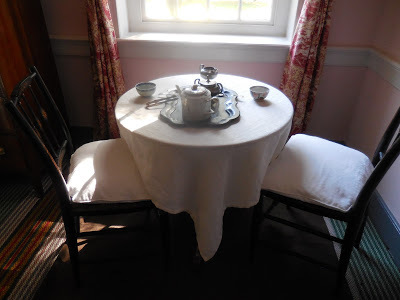
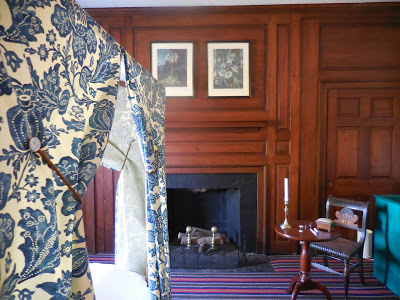 The Croghan bedroom
The Croghan bedroom
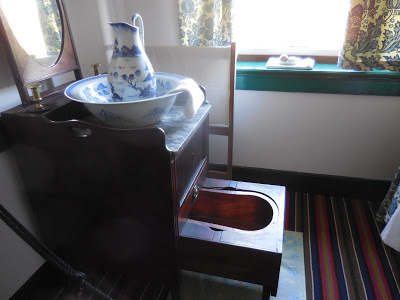
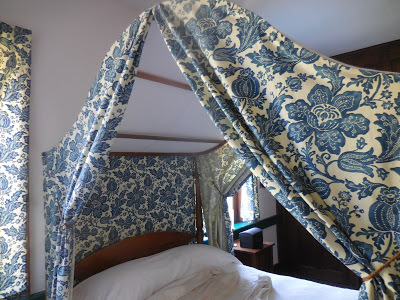
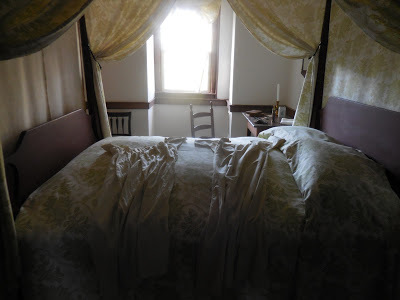 Above and below, the third floor girl's bedroom
Above and below, the third floor girl's bedroom
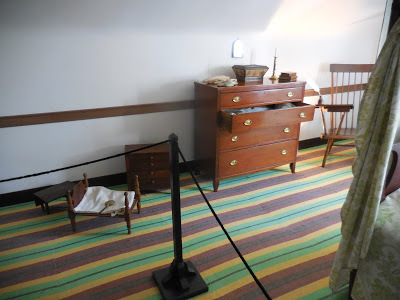
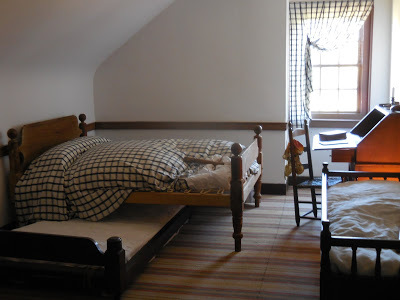 Above and below third floor boy's bedroom
Above and below third floor boy's bedroom
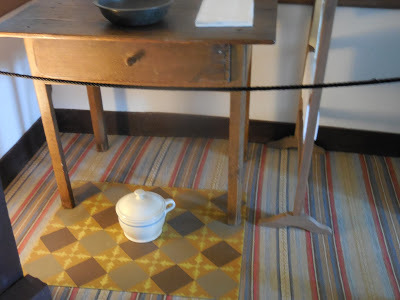
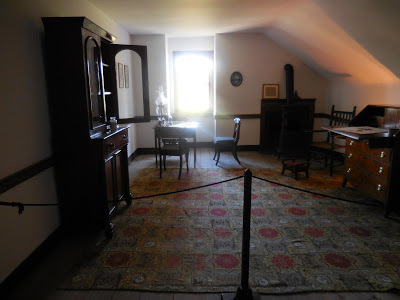 From the website: "In this room, out of our usual time frame, it’s the 1840s. This represents the history of the house after William Croghan’s death in 1822, when the next generations moved in and out of the shared house. This room focuses on John Croghan (the eldest son), and his work as a doctor and as the owner of Mammoth Cave."
From the website: "In this room, out of our usual time frame, it’s the 1840s. This represents the history of the house after William Croghan’s death in 1822, when the next generations moved in and out of the shared house. This room focuses on John Croghan (the eldest son), and his work as a doctor and as the owner of Mammoth Cave."
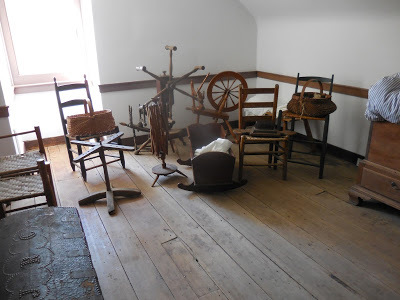 Third floor Storage Room (wish I had one of these)
Third floor Storage Room (wish I had one of these)
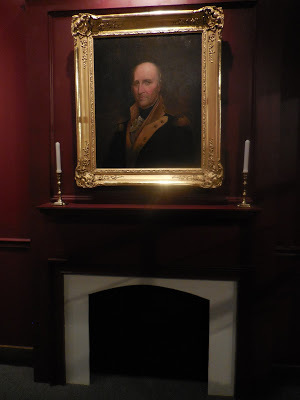 In the Museum, a portrait of General George Rogers Clark by Matthew Jouett, ca. 1825
In the Museum, a portrait of General George Rogers Clark by Matthew Jouett, ca. 1825
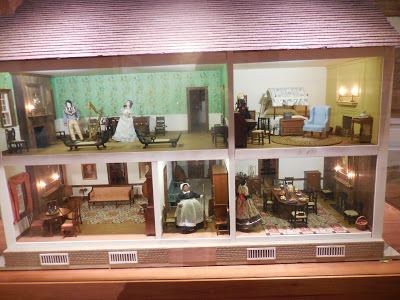 Also in the Museum, a dollhouse model of the house
Also in the Museum, a dollhouse model of the house
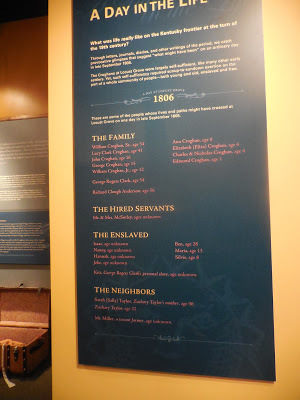 Text Panels n the Museum tell the story of the farm, the family, and early life in 18th century Kentucky, as well as the story of General Clark and William Clark, a cousin who explored to the Pacific with Meriwether Lewis in 1804-06.
Text Panels n the Museum tell the story of the farm, the family, and early life in 18th century Kentucky, as well as the story of General Clark and William Clark, a cousin who explored to the Pacific with Meriwether Lewis in 1804-06.
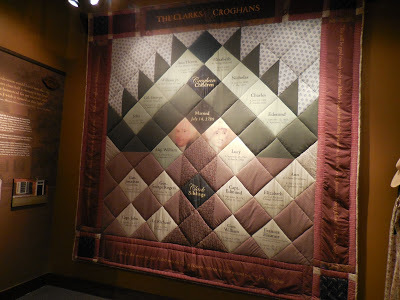 Family Quilt made for the museum
Family Quilt made for the museum
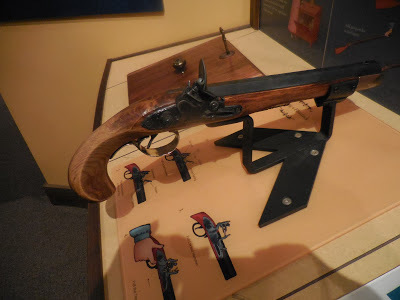 18th C. Pistol
18th C. Pistol
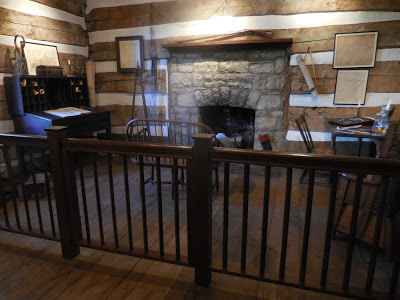 Approximation of an 18th C. Surveyor's Cabin, such as William Groghan would have built on his property; remnants of such a building were discovered in the garden a few years ago.
Approximation of an 18th C. Surveyor's Cabin, such as William Groghan would have built on his property; remnants of such a building were discovered in the garden a few years ago.
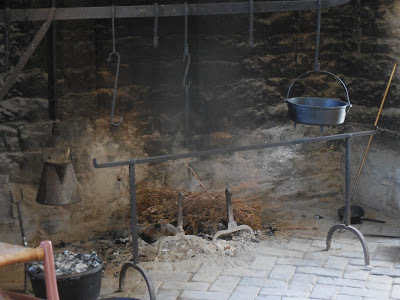 The kitchen is in a nearby outbuilding, as would have been usual in the 18th C.
The kitchen is in a nearby outbuilding, as would have been usual in the 18th C.
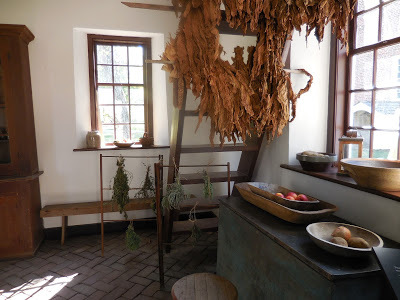 Above and below, other views of the kitchen
Above and below, other views of the kitchen
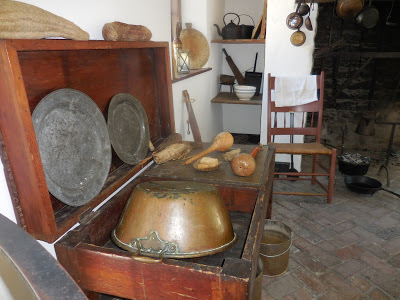
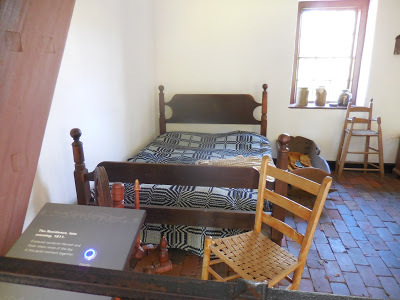 Adjacent to the kitchen is a room set up for a servant or a slave, above and below.
Adjacent to the kitchen is a room set up for a servant or a slave, above and below.
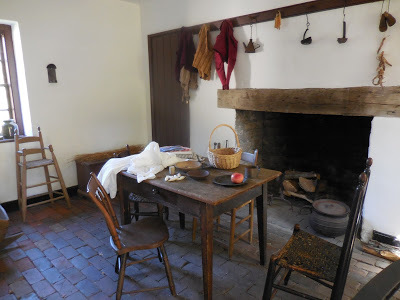
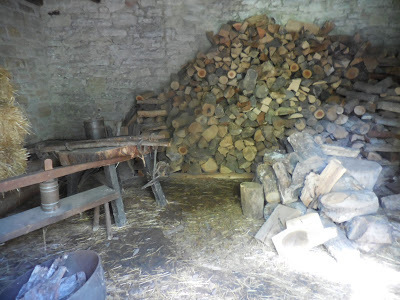 Wood storage
Wood storage
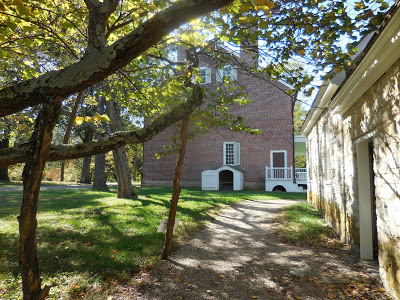 showing the outbuildings (right) and cellar door
showing the outbuildings (right) and cellar door
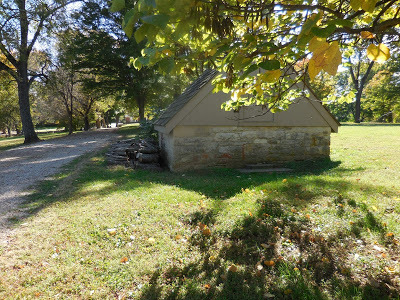 Ice House
Ice House
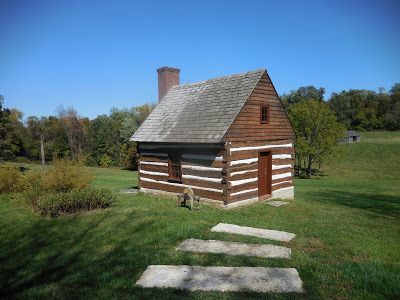
above and below, cabin built in 1815
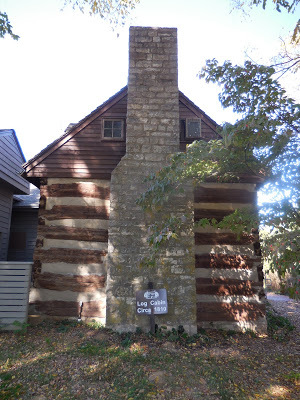
Take a virtual tour of Locust Grove here.
To read about slave life at Locust Grove, click here.
Locust Grove is a National Historic Landmark, operated by a foundation for the City of Louisville.If you can make it to Louisville, be sure to consult the on-line schedule of events, and visit when the place is teeming with reenactors, antique dealers and/or more tourists!
 The lovely bright sunshine prevented me from photographing this side of the mansion.This view is from their website, here.
The lovely bright sunshine prevented me from photographing this side of the mansion.This view is from their website, here.Also from the website: "This c.1792 Georgian mansion tells the story of its builders, William and Lucy Clark Croghan, and the story of American beginnings. William and Lucy Clark Croghan, along with Lucy’s brother, General George Rogers Clark, welcomed a generation of American luminaries to their home to rest, dialogue, campaign, and duel. Presidents James Monroe and Andrew Jackson, John James Audubon, Cassius Marcellus Clay, and Lewis and Clark—among others—all passed through Locust Grove. Now a National Historic Landmark, Locust Grove is a unique example of early Kentucky architecture, craftsmanship, and history."
The rest of the pictures are mine. And a perfect day for the camera it was.

 The garden was moving into its post-harvest phase.
The garden was moving into its post-harvest phase.

Below are portraits of Lucy Clark (1765-1838) and William Croghan (1752-1822) in the Dining Room.
 Note the the hand-blocked wallpaper design.
Note the the hand-blocked wallpaper design.

 The silver coffee and tea service was made in Philadelphia with the family crest.
The silver coffee and tea service was made in Philadelphia with the family crest. Dining Room, as it was in 1811
Dining Room, as it was in 1811
Small parlor, as of 1815

 Again, the drawing room wallpaper is worthy of note.
Again, the drawing room wallpaper is worthy of note.
 The imported Brussels carpet is particularly fine.
The imported Brussels carpet is particularly fine. Bedroom of George Rogers Clark from 1809 until his death in 1818
Bedroom of George Rogers Clark from 1809 until his death in 1818 More fascinating wallpaper, with an American Revolutionary theme
More fascinating wallpaper, with an American Revolutionary theme These walls of the Farm Office are painted in verdigris, which was explained as an odiferous compound in which one part was urine or excrement. Rarely used in bedroom I presume.
These walls of the Farm Office are painted in verdigris, which was explained as an odiferous compound in which one part was urine or excrement. Rarely used in bedroom I presume. Central Hall on the Ground Floor
Central Hall on the Ground Floor Family Guest Room: I found the striped carpeting interesting.
Family Guest Room: I found the striped carpeting interesting. Great Parlour on the second floor, as of 1811, used for family gatherings, as a ballroom, for playing games and many other activities.
Great Parlour on the second floor, as of 1811, used for family gatherings, as a ballroom, for playing games and many other activities.
 According to the website, " The fortepiano was made by Broadwood in London in 1806 and is still used for concerts."
According to the website, " The fortepiano was made by Broadwood in London in 1806 and is still used for concerts."

 The wallpaper is a reproduction of the original Arabesque pattern.
The wallpaper is a reproduction of the original Arabesque pattern.  The Rose Room, with cradle, below
The Rose Room, with cradle, below


 The Croghan bedroom
The Croghan bedroom

 Above and below, the third floor girl's bedroom
Above and below, the third floor girl's bedroom
 Above and below third floor boy's bedroom
Above and below third floor boy's bedroom
 From the website: "In this room, out of our usual time frame, it’s the 1840s. This represents the history of the house after William Croghan’s death in 1822, when the next generations moved in and out of the shared house. This room focuses on John Croghan (the eldest son), and his work as a doctor and as the owner of Mammoth Cave."
From the website: "In this room, out of our usual time frame, it’s the 1840s. This represents the history of the house after William Croghan’s death in 1822, when the next generations moved in and out of the shared house. This room focuses on John Croghan (the eldest son), and his work as a doctor and as the owner of Mammoth Cave." Third floor Storage Room (wish I had one of these)
Third floor Storage Room (wish I had one of these) In the Museum, a portrait of General George Rogers Clark by Matthew Jouett, ca. 1825
In the Museum, a portrait of General George Rogers Clark by Matthew Jouett, ca. 1825 Also in the Museum, a dollhouse model of the house
Also in the Museum, a dollhouse model of the house Text Panels n the Museum tell the story of the farm, the family, and early life in 18th century Kentucky, as well as the story of General Clark and William Clark, a cousin who explored to the Pacific with Meriwether Lewis in 1804-06.
Text Panels n the Museum tell the story of the farm, the family, and early life in 18th century Kentucky, as well as the story of General Clark and William Clark, a cousin who explored to the Pacific with Meriwether Lewis in 1804-06. Family Quilt made for the museum
Family Quilt made for the museum 18th C. Pistol
18th C. Pistol Approximation of an 18th C. Surveyor's Cabin, such as William Groghan would have built on his property; remnants of such a building were discovered in the garden a few years ago.
Approximation of an 18th C. Surveyor's Cabin, such as William Groghan would have built on his property; remnants of such a building were discovered in the garden a few years ago. The kitchen is in a nearby outbuilding, as would have been usual in the 18th C.
The kitchen is in a nearby outbuilding, as would have been usual in the 18th C. Above and below, other views of the kitchen
Above and below, other views of the kitchen
 Adjacent to the kitchen is a room set up for a servant or a slave, above and below.
Adjacent to the kitchen is a room set up for a servant or a slave, above and below.
 Wood storage
Wood storage  showing the outbuildings (right) and cellar door
showing the outbuildings (right) and cellar door Ice House
Ice House
above and below, cabin built in 1815

Take a virtual tour of Locust Grove here.
To read about slave life at Locust Grove, click here.
Locust Grove is a National Historic Landmark, operated by a foundation for the City of Louisville.If you can make it to Louisville, be sure to consult the on-line schedule of events, and visit when the place is teeming with reenactors, antique dealers and/or more tourists!
Published on October 28, 2015 00:30
October 25, 2015
ON THE SHELF: DO YOU GET BOOKS? PART TWO
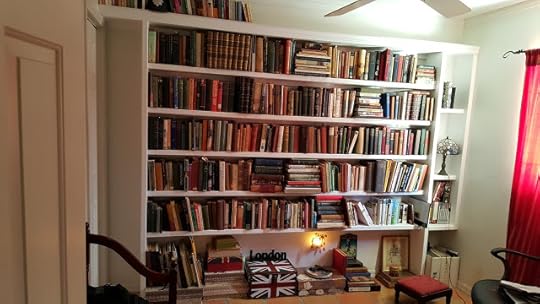
I'm happy to report that the built-in bookshelves are done and painted and my library is back where it belongs. Although most books can now be found on the internet, I'm never parting with my core library, consisting primarily of books on London, Wellington, Brummell, period diaries and letters and Queen Victoria. For those of you who have expressed an interest in browsing my bookshelves, here's a good representation of what they hold.
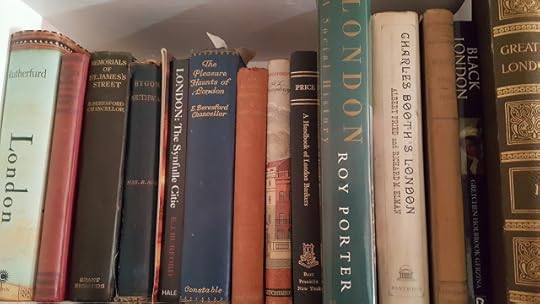
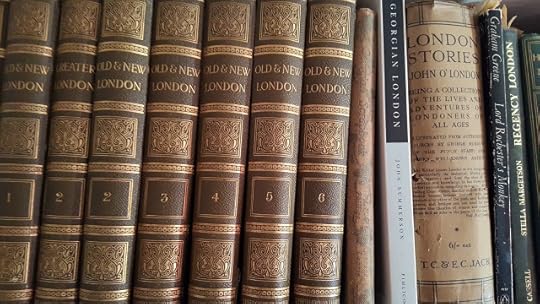
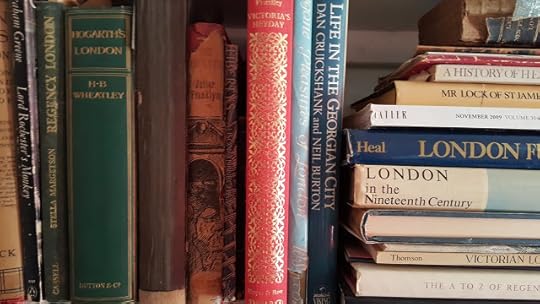
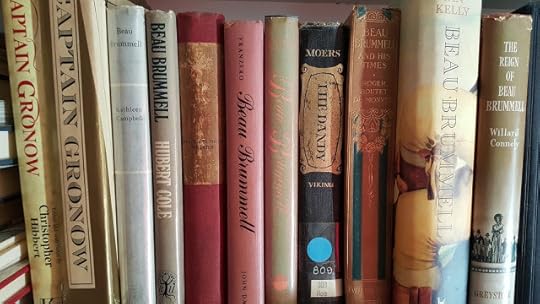
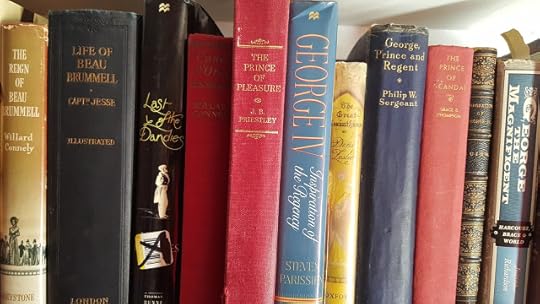
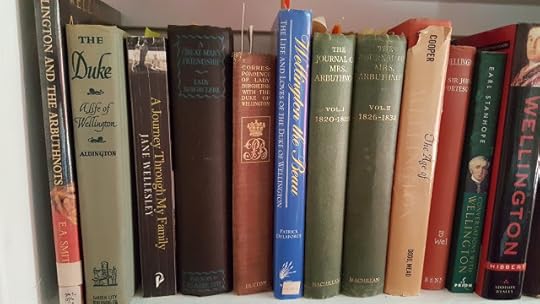
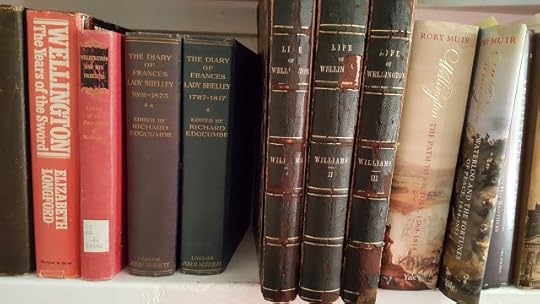
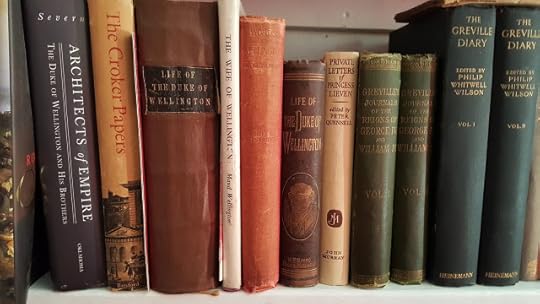
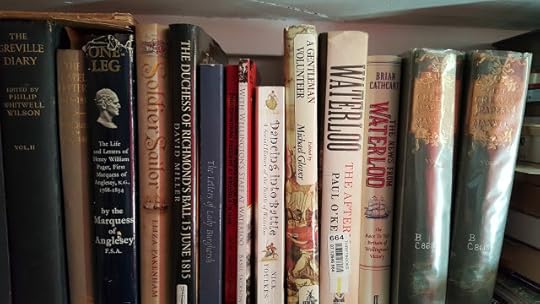
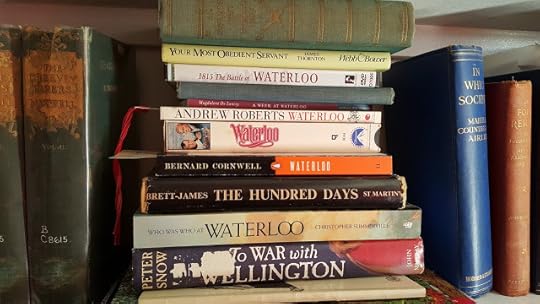
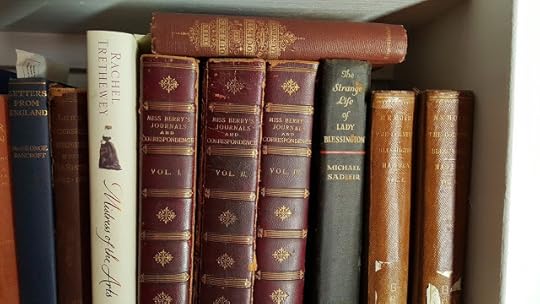
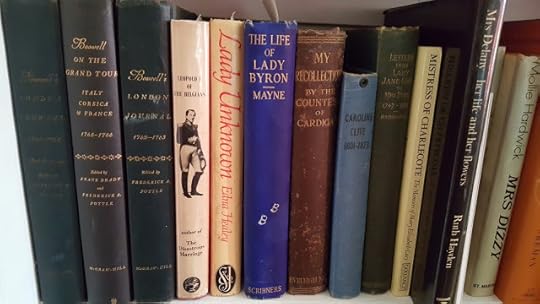
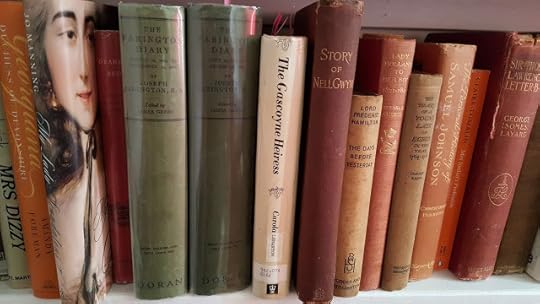
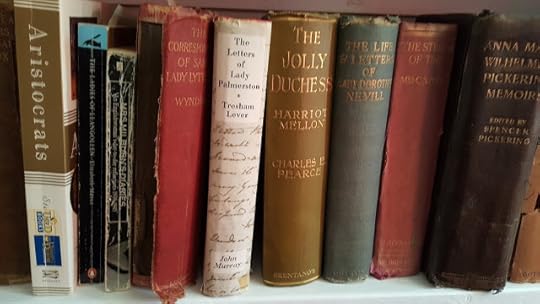
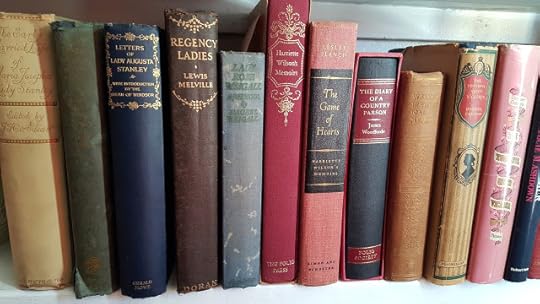
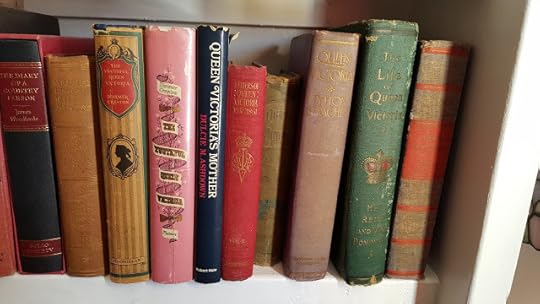
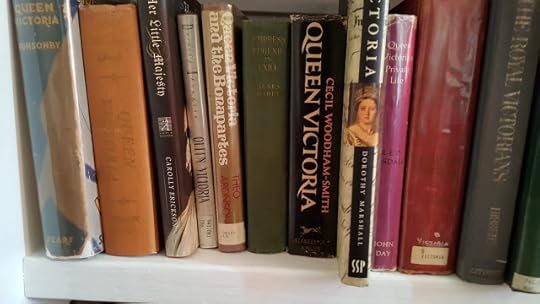
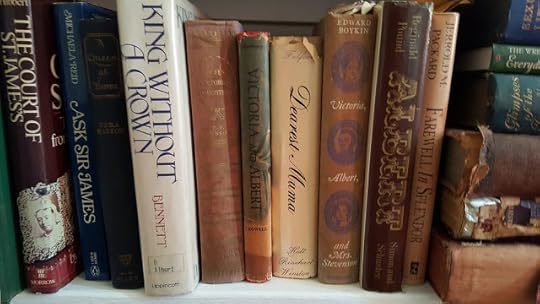
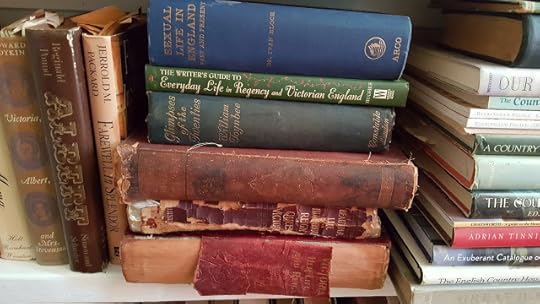
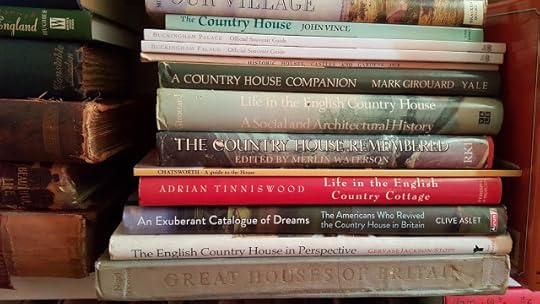
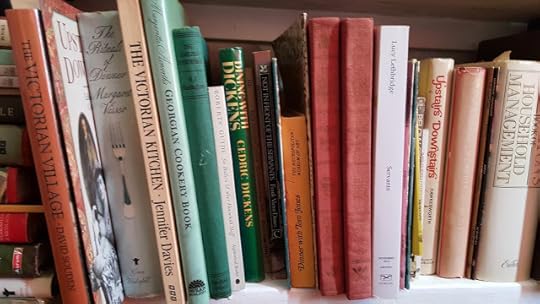
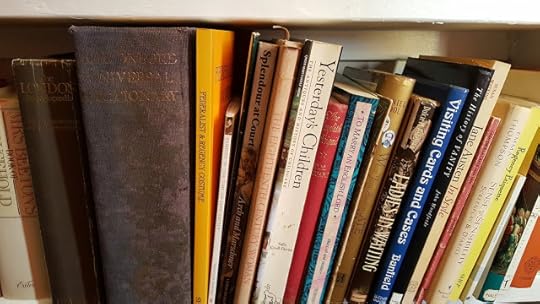
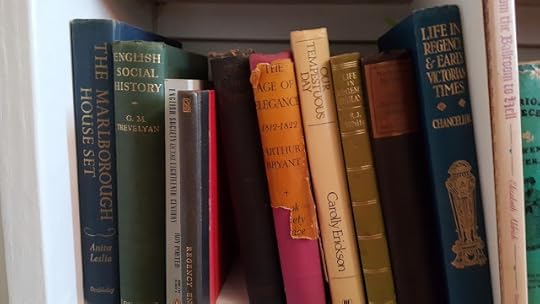
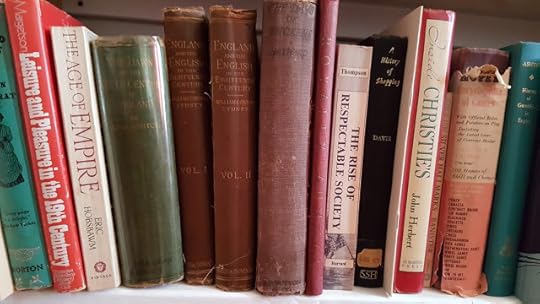
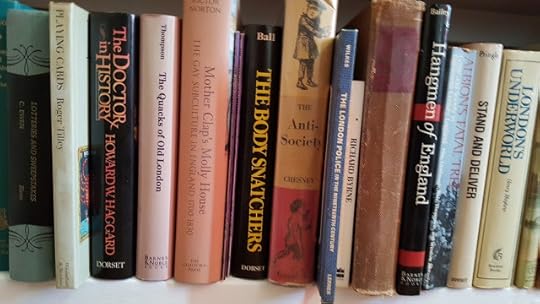
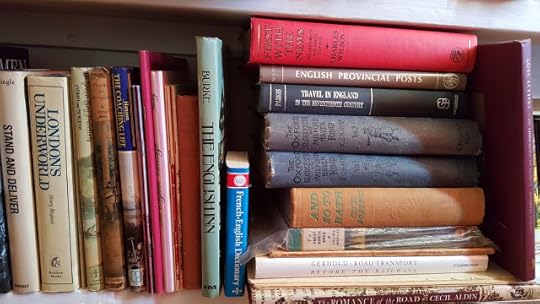
Published on October 25, 2015 23:30
October 23, 2015
THE DUKE OF WELLINGTON TOUR: BETH ELLIOTT AND READING ABBEY
After leaving Stratfield Saye, our coach made a pit stop at the Wellington Farm Shop

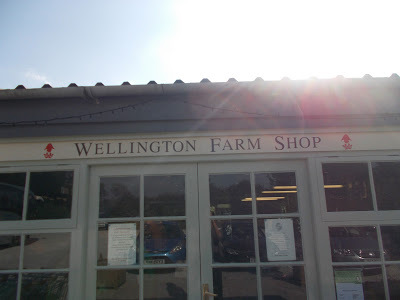
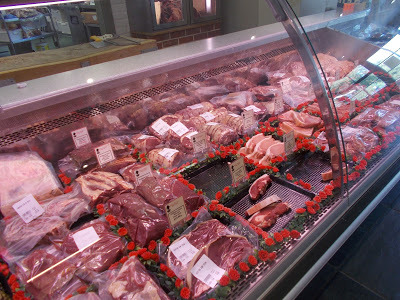
As you can see, the market had many enticing items, but as none of us were going to be cooking any time soon, the majority of our group settled for homemade fudge.

Back at our "atmospheric" coaching inn in Reading, we looked forward to meeting Regency author Beth Elliott, who very kindly agreed to take us on a walking tour of the ruins of the Reading Abbey, including the Abbey Gateway, where Jane Austen attended Madame La Tournelle's school in 1784-85.
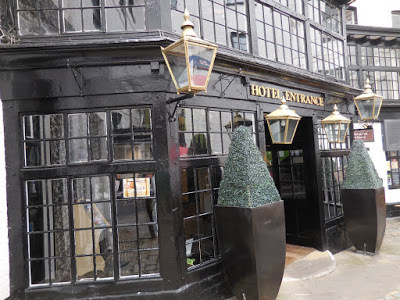
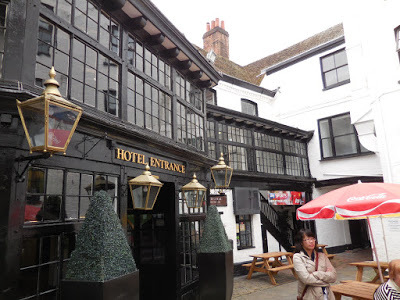
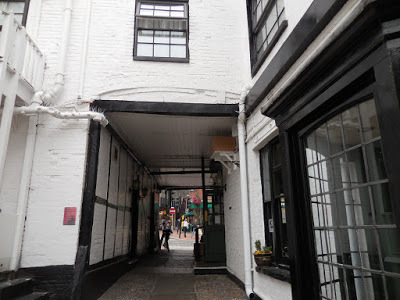
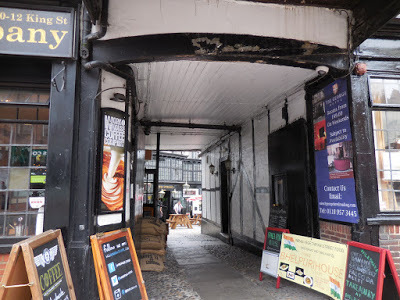 Above, the Mercure George Hotel, ReadingSaid to be from the 15th Century
Above, the Mercure George Hotel, ReadingSaid to be from the 15th Century
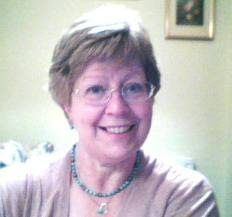 Beth Elliott's Websites are here and here.
Beth Elliott's Websites are here and here.
As we walked toward the Abbey Ruins, now largely blocked off, we saw many structures probably constructed with materials from the Abbey Ruins.
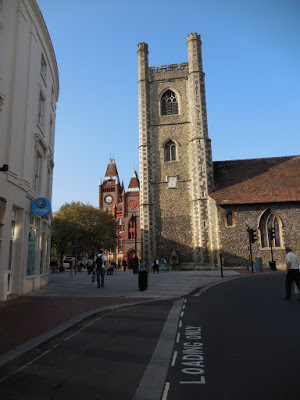
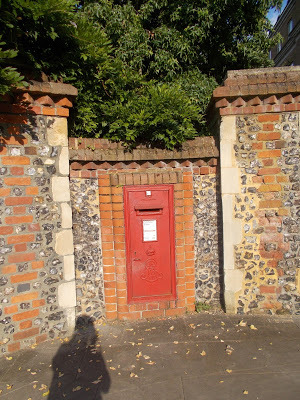
Below Diane Gaston. Beth Elliott, and Victoria in front of the Abbey Gateway.
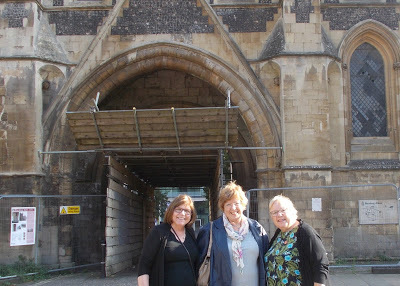
The painting below, by artist Paul Sandby, shows the Abbey Gateway in 1808, a few years after Austen and her sister Cassandra attended school there.
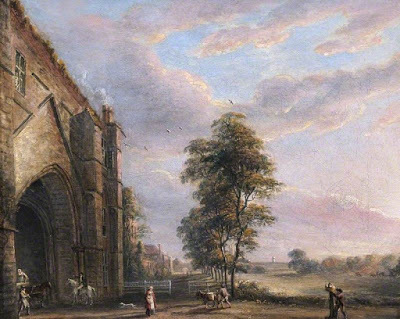
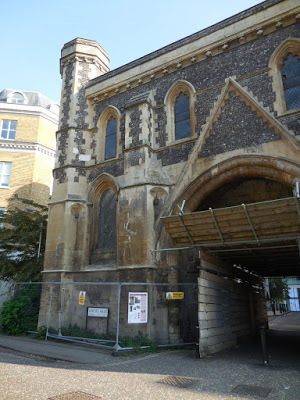
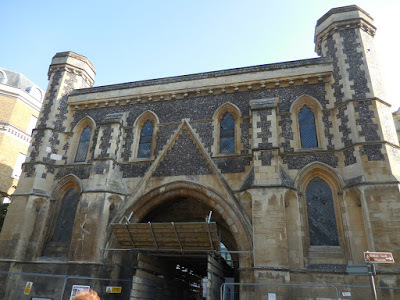
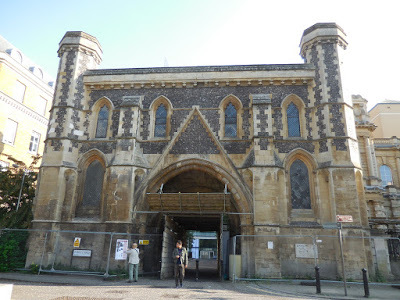
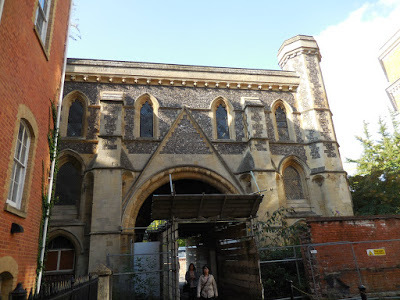
The Abbey Gateway Building is obviously waiting for a restoration project being sought by the city of Reading, as are the remaining ruins, now apparently considered unsafe and fenced off.
But a few of the details on the Gateway can be seen below, though who these royal heads belong to, we cannot tell.
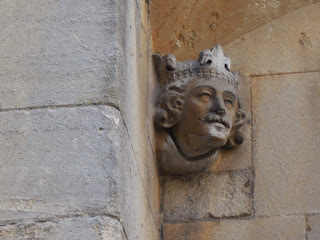
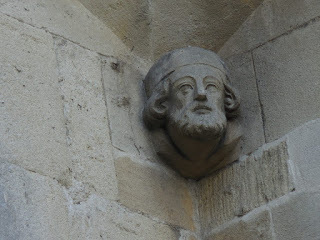
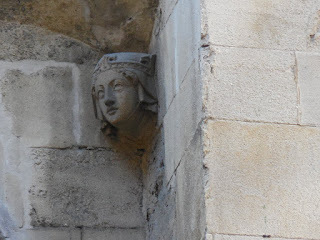
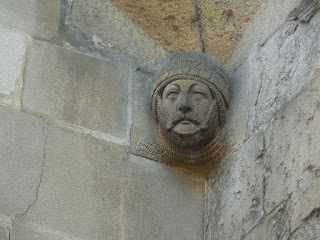
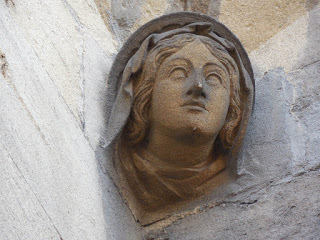
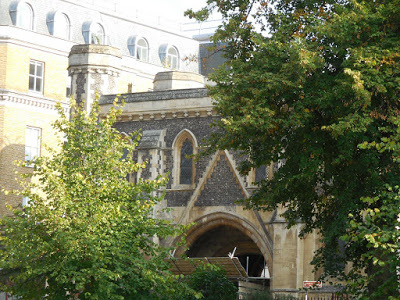
The Abbey was founded in 1121 by King Henry I, youngest son of William the Conqueror. During the time of Henry VIII, the Dissolution of the Monasteries brought the destruction of the Abbey buildings in 1539, though ruins remain widespread along the river and elsewhere in Forbury Gardens.
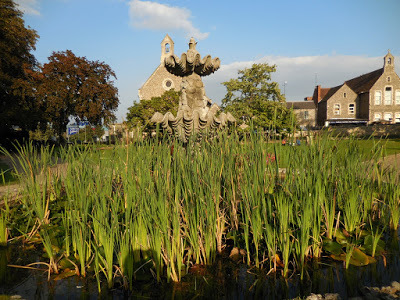
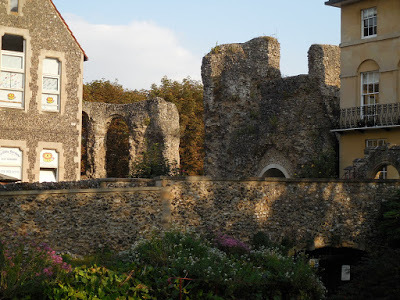
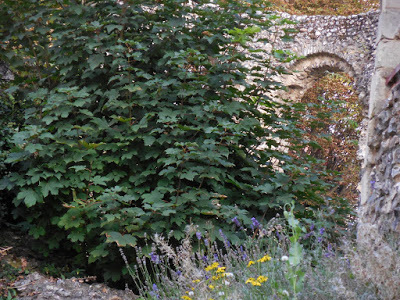
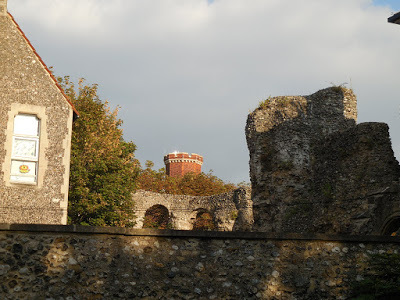
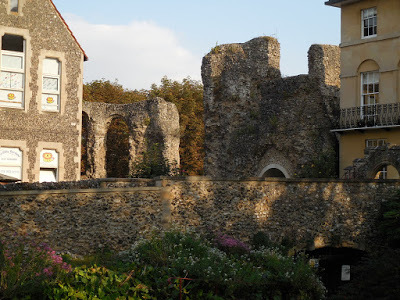
Forbury Gardens is a lovely public park established in the area long ago known as the forbury, meaning "the borough in front" occupying the hill between the Abbey and the town of Reading. Markets, fairs, and other events were held in the area.
The center of the park is dominated by the 1888 noble statue of the Maiwand Lion which memorializes the hundreds of Berkshire soldiers who perished in the Battle of Maiwand in Afganistan in 1880. Over thirty feet high, the lion was sculpted by George Blackall Simonds.
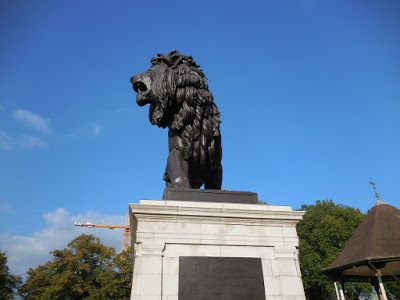
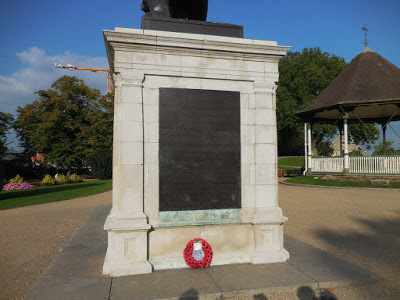 a recent memorial
a recent memorial
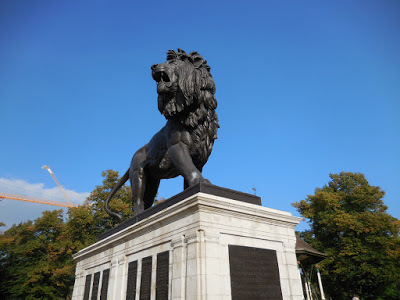
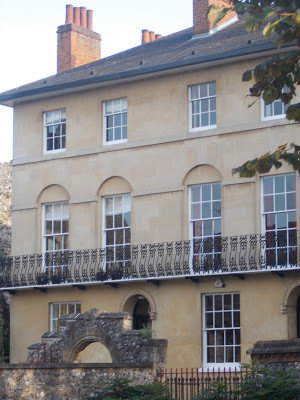
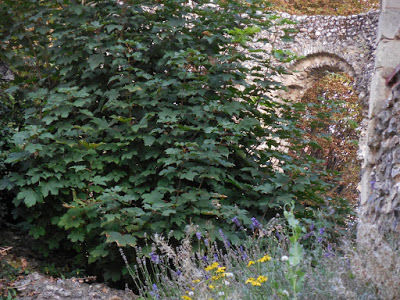
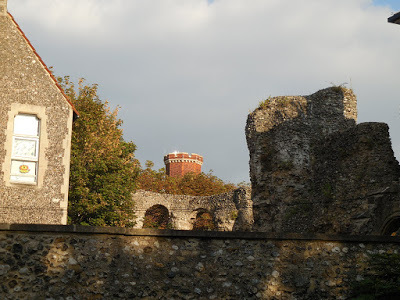
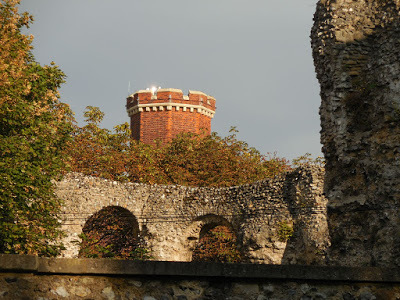
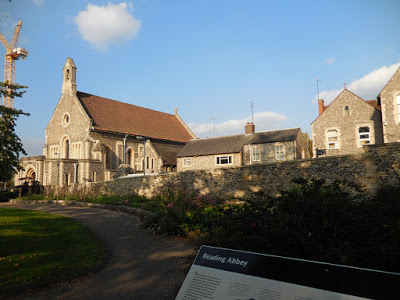
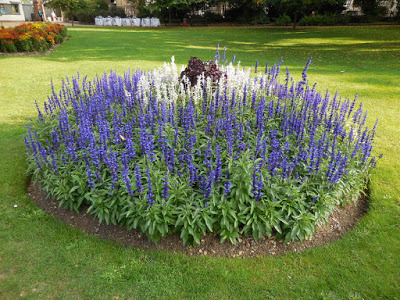
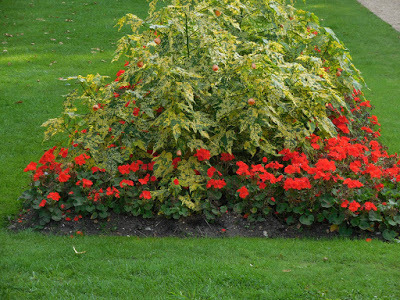
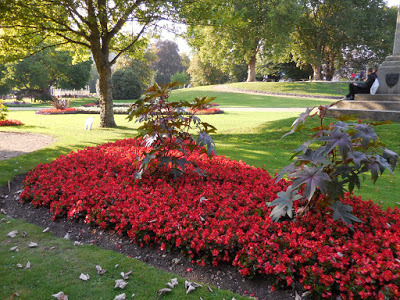 The gardens bloomed with late summer intensity.
The gardens bloomed with late summer intensity.
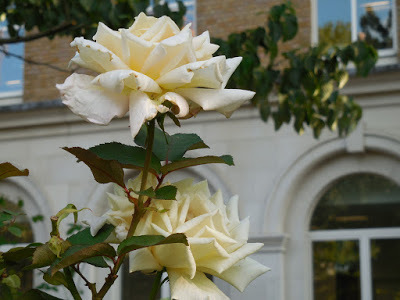
After the Abbey Ruins and the Gardens, Beth took us to a pub, where her lucky critique group has their meetings in a private room. We walked across the Kennet River
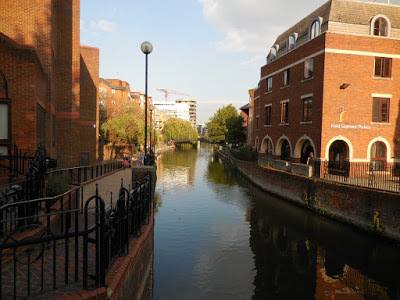
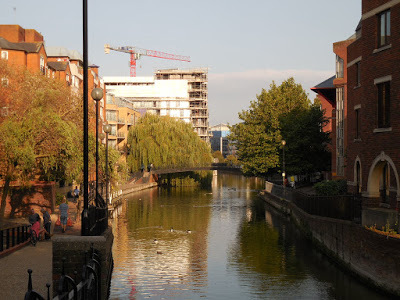
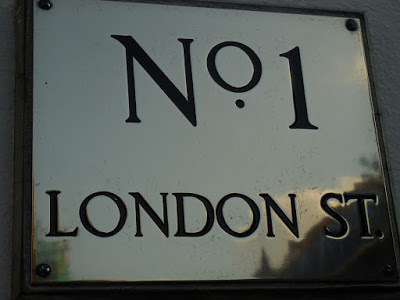 Oh! Our very own sign, along the way!
Oh! Our very own sign, along the way!
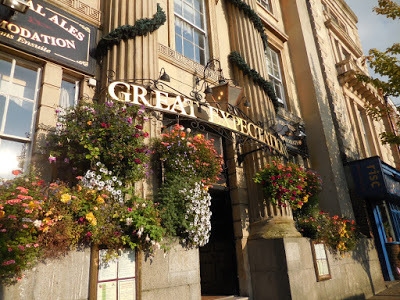
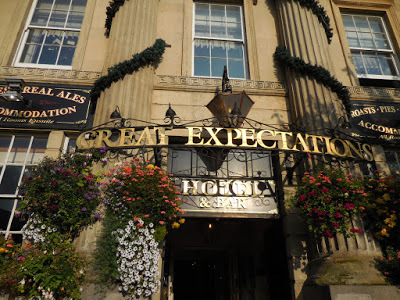 Great Expectations is a hotel and pub, named after a series of readings given here by Charles Dickens. Beth's critique group meets in a book-lined room which must offer its own Great Expectations for her lucky critique group.
Great Expectations is a hotel and pub, named after a series of readings given here by Charles Dickens. Beth's critique group meets in a book-lined room which must offer its own Great Expectations for her lucky critique group.
Reading offers many more possibilities for exploration as well. Someday we will return and pursue them! For now, we enjoyed a dinner with the group and prepared for a busy day coming up. Join us next time for a visit to Highclere Castle, aka Downton Abbey.



As you can see, the market had many enticing items, but as none of us were going to be cooking any time soon, the majority of our group settled for homemade fudge.

Back at our "atmospheric" coaching inn in Reading, we looked forward to meeting Regency author Beth Elliott, who very kindly agreed to take us on a walking tour of the ruins of the Reading Abbey, including the Abbey Gateway, where Jane Austen attended Madame La Tournelle's school in 1784-85.



 Above, the Mercure George Hotel, ReadingSaid to be from the 15th Century
Above, the Mercure George Hotel, ReadingSaid to be from the 15th Century Beth Elliott's Websites are here and here.
Beth Elliott's Websites are here and here.As we walked toward the Abbey Ruins, now largely blocked off, we saw many structures probably constructed with materials from the Abbey Ruins.


Below Diane Gaston. Beth Elliott, and Victoria in front of the Abbey Gateway.

The painting below, by artist Paul Sandby, shows the Abbey Gateway in 1808, a few years after Austen and her sister Cassandra attended school there.





The Abbey Gateway Building is obviously waiting for a restoration project being sought by the city of Reading, as are the remaining ruins, now apparently considered unsafe and fenced off.
But a few of the details on the Gateway can be seen below, though who these royal heads belong to, we cannot tell.






The Abbey was founded in 1121 by King Henry I, youngest son of William the Conqueror. During the time of Henry VIII, the Dissolution of the Monasteries brought the destruction of the Abbey buildings in 1539, though ruins remain widespread along the river and elsewhere in Forbury Gardens.





Forbury Gardens is a lovely public park established in the area long ago known as the forbury, meaning "the borough in front" occupying the hill between the Abbey and the town of Reading. Markets, fairs, and other events were held in the area.
The center of the park is dominated by the 1888 noble statue of the Maiwand Lion which memorializes the hundreds of Berkshire soldiers who perished in the Battle of Maiwand in Afganistan in 1880. Over thirty feet high, the lion was sculpted by George Blackall Simonds.

 a recent memorial
a recent memorial







 The gardens bloomed with late summer intensity.
The gardens bloomed with late summer intensity.
After the Abbey Ruins and the Gardens, Beth took us to a pub, where her lucky critique group has their meetings in a private room. We walked across the Kennet River


 Oh! Our very own sign, along the way!
Oh! Our very own sign, along the way!
 Great Expectations is a hotel and pub, named after a series of readings given here by Charles Dickens. Beth's critique group meets in a book-lined room which must offer its own Great Expectations for her lucky critique group.
Great Expectations is a hotel and pub, named after a series of readings given here by Charles Dickens. Beth's critique group meets in a book-lined room which must offer its own Great Expectations for her lucky critique group.Reading offers many more possibilities for exploration as well. Someday we will return and pursue them! For now, we enjoyed a dinner with the group and prepared for a busy day coming up. Join us next time for a visit to Highclere Castle, aka Downton Abbey.
Published on October 23, 2015 00:30
October 20, 2015
THEY PAVED PARADISE . . . . AND MADE HOUGOUMONT INTO A B&B
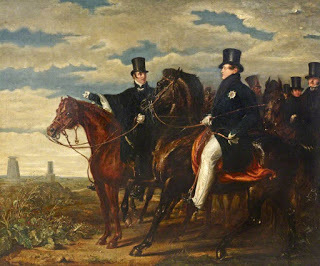
The Duke of Wellington Describing the Field of Waterloo to HM George IV by Benjamin Robert HaydonDate painted: 1840 - Royal Hospital, Chelsea
Duke of Wellington showing the field of battle of his greatest victory over the French to the young Queen Victoria
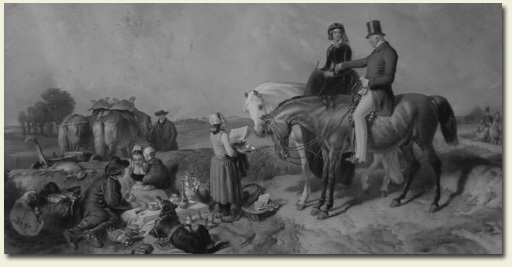 A DIALOGUE AT WATERLOO
A DIALOGUE AT WATERLOO"The most infamous army I ever commanded..."Engraved By T.H. Atkinson after Sir Edwin Landseer. London Ca.1851
-The Iron Duke on his troops at Waterloo.
As immortalized in the paintings above, the Duke of Wellington did indeed return to the field of battle at Waterloo, often accompanied by prestigious guests. When he saw the Lion's Mound for the first time, he lamented, "They have ruined my battlefield." I don't think that the Duke objected to the Mound itself, but rather to the fact that much of the dirt needed for the Mound was taken from the famous ridge behind which Wellington had placed his troops at a critical point in the battle. Ordered to lay down, the massive lines of British troops could not be seen by the advancing French, who believed that they had managed to catch Wellington unprepared and that victory would soon be theirs. As the French cavalry advanced, Wellington bided his time until the very last moment, when it is said that he ordered, "Up, men and at them!" Suddenly, the French found themselves confronted by the Long Red Line, fully armed with weapons cocked. Wellington had studied the ridge long before the Battle ever began and came prepared to use it to his advantage should the opportunity arise. The ridge was integral to the British victory at Waterloo and the construction of the Mound had diminished the scale of the ridge. Thus, Wellington was perturbed.
I was also perturbed, to say the least, when I first heard rumours of the plans to turn Hougoumont into a B and B. Victoria and I had visited Hougoumont together in 2010 - you can read that blog post here.
Throughout the Battle of Waterloo, Wellington was committed to British forces maintaining control of the farmhouse of Hougoumont, a strategic battle postition. From Wikipedia:
Wellington recorded in his despatches "at about ten o'clock [Napoleon] commenced a furious attack upon our post at Hougoumont" Other sources state that this attack was at about 11:30. The historian Andrew Roberts notes that, "It is a curious fact about the battle of Waterloo that no one is absolutely certain when it actually began".The initial attack by Maréchal de Camp Bauduin's 1st Brigade of the 6th Division emptied the wood and park, but was driven back by heavy British artillery fire and cost Bauduin his life. The British guns were distracted into an artillery duel with French guns and this allowed a second attack by Maréchal de Camp Baron Soye's 2nd Brigade of the 6th Division. They managed a small breach on the south side but could not exploit it. An attack on the north side by elements of the 1st Brigade of the 6th Division was more successful.This attack led to one of the most famous skirmishes in the Battle of Waterloo — Sous-Lieutenant Legros, wielding an axe, managed to break through the north gate. A desperate fight ensued between the invading French soldiers and the defending Guards. In a near-miraculous attack, Macdonell, a small party of officers and Corporal James Graham fought through the melee to shut the gate, trapping Legros and about 30 other soldiers of the 1st Legere inside. All of the French who entered, apart from a young drummer boy, were killed in a desperate hand-to-hand fight.
Today, Hougoumont stands as a monumount to British bravery and to those who fought and died on the field as the Battle raged. As Paul Bray wrote in a Telegraph article in July 2014:
Most of the farms are private and only visible from the outside. The glorious exception is Hougoumont, where three Guards regiments secured Wellington’s right flank throughout the battle.In danger of collapse a few years ago, it is now being restored – thanks in part to a surprise £1million grant from the UK Treasury – and its official public opening will be a centrepiece of next June’s bicentenary celebrations.
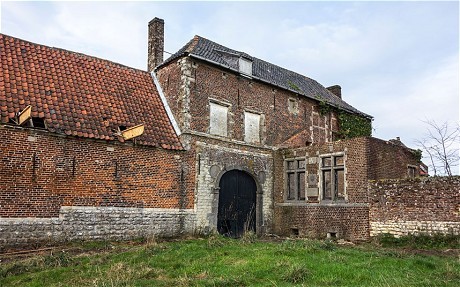 Hougoumont, the farmhouse that played a significant roleThe trees here are still bark-scarred by grapeshot, doors are riddled by musket balls – testimony to the more than 6,000 men killed or wounded in its attack and defence.According to Graeme Cooper, founder of the Guild of Battlefield Guides: “The story here is most vivid. I have seen many visitors with tears in their eyes, not just because Hougoumont is a shrine to the British Guards but because the atmosphere is so heart-rending. If Hougoumont fails to engage one’s imagination with history, nowhere else will.”
Hougoumont, the farmhouse that played a significant roleThe trees here are still bark-scarred by grapeshot, doors are riddled by musket balls – testimony to the more than 6,000 men killed or wounded in its attack and defence.According to Graeme Cooper, founder of the Guild of Battlefield Guides: “The story here is most vivid. I have seen many visitors with tears in their eyes, not just because Hougoumont is a shrine to the British Guards but because the atmosphere is so heart-rending. If Hougoumont fails to engage one’s imagination with history, nowhere else will.”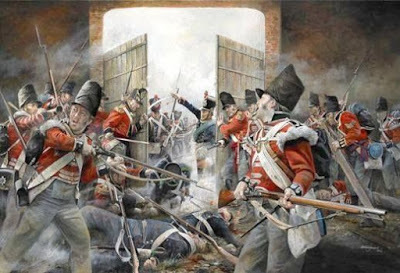
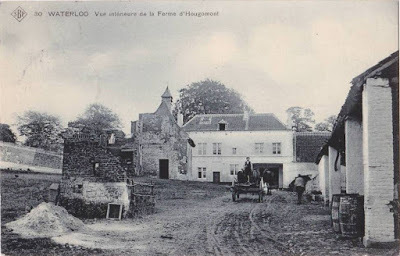
Hougoumont 1915Wikimedia Commons
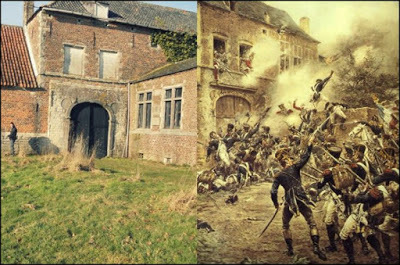
Hougoumont today and in 1815Thanks to Robbie MacNiven
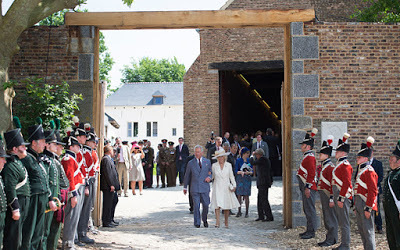
Prince Charles and The Duchess of Cornwall visiting the Battlefield and Hougoumont 2015
Several years ago, Project Hougoumont, supported by the late and present Dukes of Wellington, had undertaken the monumental mission of restoring Hougoumont and the surrounding land in order to preserve this most important site. You can visit the Project Hougoumont website here and watch a very informative video regarding the site featuring historian and presenter Peter Snow. We have had a link to the Project in the left hand sidebar of this blog for over a year now and we applaud their efforts to save the site for future generations to appreciate.
All was right with world until I read this blurb by the Landmark Trust several months ago: "Just before Christmas it was announced that the Landmark Trust, working with Project Hougoumont, had submitted the only viable tender for the lease of the apartment on the first and second floors of the gardener’s house. So, our dream of creating a place where people can stay and study the battlefield by day and night and in all kinds of weather has come true. The windows of the light and airy apartment look into the courtyard in one direction and towards the position of the French line in the other. The Landmark Trust assures us that it will be furnished and ready for occupation by 17 June."
To repeat, upon learning of plans to turn Hougoumont into a B and B, I was perturbed. Okay, outraged might be closer to the mark. How could anyone be allowed to turn this sacred site into a money making venture? What was next - Waterloo Land? Wellington World? How had such a venture passed through the scrutiny of such a venerable restoration committee?
Recently, I put my displeasure aside and actually went to the Landmark Trust website for the accommodations at Hougoumont. From the website:
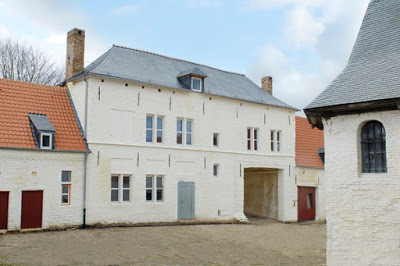
The walls of the courtyard have been limewashed but the brickwork of the external elevations has been left exposed, as it was during the battle.
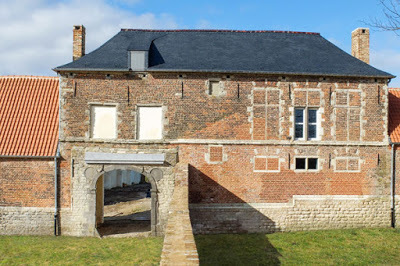
I had to admit, Hougoumont looks much improved and the massive restoration project seems to have been sympathetically done. Hhhmmmm . . . . but what would the interiors of the two bedroom guest accommodation look like? Again from the website: This simple first floor apartment in the former gardener’s cottage beside the south gates is furnished to evoke the Napoleonic era and looks out on ancient sweet chestnut trees that also witnessed the bravery and sacrifice here.
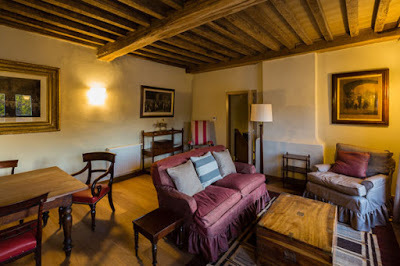
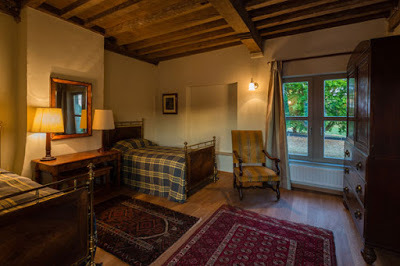
This is a unique place to ponder the famous Battle of Waterloo by day and night.
Unique, yes. And it's just the gardener's cottage that will house guest rooms. Very tastefully done guest rooms, at that. Perhaps I jumped the gun when I set my face the enterprise. In fact, staying at Hougoumont for a few nights in order to "ponder the famous Battle of Waterloo by day and night" sounds like a capital idea. Heck, it even sounds like a plan.
How do you feel about the idea?
Published on October 20, 2015 23:30
Kristine Hughes's Blog
- Kristine Hughes's profile
- 6 followers
Kristine Hughes isn't a Goodreads Author
(yet),
but they
do have a blog,
so here are some recent posts imported from
their feed.


















